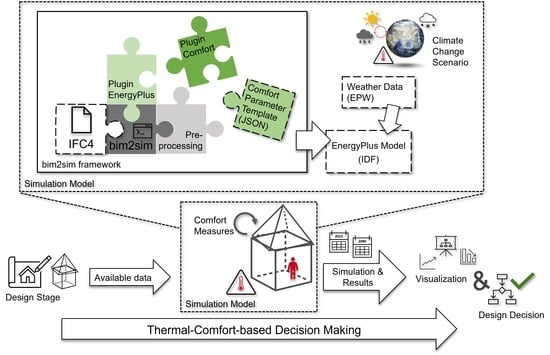Extending the IFC-Based bim2sim Framework to Improve the Accessibility of Thermal Comfort Analysis Considering Future Climate Scenarios
Abstract
:1. Introduction
1.1. Related Research
1.1.1. Thermal Comfort and Climate Change
1.1.2. IFC-Based BPS
1.1.3. Future Weather Scenarios
1.2. Aim of Study
2. Materials and Methods
2.1. Evaluate Thermal Comfort Models
2.2. Implementation of PluginComfort for bim2sim
2.3. Enrichment of Thermal Comfort Parameters for Archetypal Zone Usage
2.3.1. Enrichment of Activity Degree Parameters for Archetypal Zone Usage
2.3.2. Enrichment of Clothing Insulation Parameters for Archetypal Zone Usage
2.4. Definition of Weather Data
3. Results
3.1. Use Case: FZK-Haus
3.2. Template-Based Thermal Comfort with Cooling
3.3. Template-Based Thermal Comfort Analysis without Cooling
3.3.1. Analysis of Fanger’s PMV
3.3.2. Analysis of Adaptive Comfort
4. Discussion and Limitations
5. Conclusions
Author Contributions
Funding
Institutional Review Board Statement
Informed Consent Statement
Data Availability Statement
Conflicts of Interest
Abbreviations
| BPS | Building Performance Simulation |
| BIM | Building Information Modeling |
| CFD | Computational Fluid Dynamics |
| CMIP | Coupled Model Intercomparison Project |
| IFC | Industry Foundation Classes |
| IPCC | Intergovernmental Panel on Climate Change |
| IQR | Interquartile Range |
| LCA | Life Cycle Assessment |
| ML | Machine Learning |
| PMV | Predicted Mean Vote |
| PPD | Predicted Percentage Dissatisfied |
Appendix A. Thermal Comfort Templates
Appendix A.1. Activity Parameters
| (1) Room Type | (2) | (3) | (4) ASHRAE Fundamentals | (5) ISO 7730 | (6) | (7) | (8) Activity Degree (met) | (9) | (10) Heat flow (W/person) | (11) |
|---|---|---|---|---|---|---|---|---|---|---|
| Single office | 1.2 | 70 | Office, Typing | A.5, Single office | 1.1 | 1.2 | 1.2 | 0.0 | 125 | 55 |
| Group Office (between 2 and 6 employees) | 1.2 | 70 | Office, Typing | A.5, Landscape office | 1.1 | 1.2 | 1.2 | 0.0 | 125 | 55 |
| Open-plan Office (7 or more employees) | 1.2 | 70 | Office, Typing | A.5, Landscape office | 1.1 | 1.2 | 1.2 | 0.0 | 125 | 55 |
| Meeting, Conference, seminar | 1.2 | 70 | Office, Typing | A.5, Conference Room | 1.1 | 1.2 | 1.2 | 0.0 | 125 | 55 |
| Main Hall, Reception | 1.2 | 70 | Office Walking | B.1, Standing, light activity | 1.7 | 1.6 | 1.7 | 0.5 | 178 | 108 |
| Retail, department store | 1.2 | 70 | Office, Filing, Standing | A.5, Department store | 1.4 | 1.6 | 1.5 | 0.3 | 157 | 87 |
| Retail with cooling | 1.2 | 70 | Office, Filing, Standing | A.5, Department store | 1.4 | 1.6 | 1.5 | 0.3 | 157 | 87 |
| Class room (school), group room (kindergarden) | 1.2 | 70 | Office, Writing | A.5, Kindergarten | 1 | 1.4 | 1.2 | 0.0 | 125 | 55 |
| Lecture hall, auditorium | 1.2 | 70 | Office, Typing | A.5, Auditorium | 1.1 | 1.2 | 1.2 | 0.0 | 125 | 55 |
| Bed room | 1.2 | 70 | Resting, Sleeping | B.1, Reclining | 0.7 | 0.8 | 0.8 | 0.4 | 84 | 14 |
| Hotel room | 1.2 | 70 | Resting, Sleeping | B.1, Reclining | 0.7 | 0.8 | 0.8 | 0.4 | 84 | 14 |
| Canteen | 1.2 | 70 | Office, Filing, Seated | A.5, Cafeteria/restaurant | 1.2 | 1.2 | 1.2 | 0.0 | 125 | 55 |
| Restaurant | 1.2 | 70 | Office, Filing, Seated | A.5, Cafeteria/restaurant | 1.2 | 1.2 | 1.2 | 0.0 | 125 | 55 |
| Kitchen in non-residential buildings | 1.2 | 70 | Cooking | B.1, Standing, medium activity | 1.8 | 2 | 1.9 | 0.7 | 199 | 129 |
| Kitchen—preparations, storage | 2 | 90 | Cooking | B.1, Standing, medium activity | 1.8 | 2 | 1.9 | 0.1 | 199 | 109 |
| WC and sanitary rooms in non-residential buildings | 1.2 | 70 | Resting, Seated, quiet | B.1, Seated, relaxed | 1 | 1 | 1 | 0.2 | 105 | 35 |
| Further common rooms | 1.2 | 70 | Office, Typing | B.1, Sedentary activity | 1.1 | 1.2 | 1.2 | 0.0 | 125 | 55 |
| Auxiliary areas (without common rooms) | 1.2 | 70 | Office Walking | A.5, Department store | 1.7 | 1.6 | 1.7 | 0.5 | 178 | 108 |
| Traffic area | 1.2 | 70 | Office Walking | B.1, Walking, 2 km/h | 1.7 | 1.9 | 1.8 | 0.6 | 188 | 118 |
| Stock, technical equipment, archives | 2 | 90 | Office, Filing, Standing | B.1, Standing, light activity | 1.4 | 1.6 | 1.5 | 0.5 | 157 | 67 |
| Data center | 1.2 | 70 | Office, Filing, Standing | B.1, Standing, light activity | 1.4 | 1.6 | 1.5 | 0.3 | 157 | 87 |
| Commercial and industrial Halls—heavy work, standing activity | 2 | 90 | Machine work, heavy | B.1, Walking, 5 km/h | 4 | 3.4 | 3.7 | 1.7 | 387 | 297 |
| Commercial and industrial Halls—medium work, standing activity | 1.6 | 80 | Machine work, light (electrical industry) | B.1, Standing, medium activity | 2.2 | 2 | 2.1 | 0.5 | 220 | 140 |
| Commercial and industrial Halls—light work, standing activity | 1.2 | 70 | Machine work, sawing | B.1, Standing, light activity | 1.8 | 1.6 | 1.7 | 0.5 | 178 | 108 |
| Spectator area (theater and event venues) | 1.2 | 70 | Resting, Seated, quiet | A.5, Auditorium | 1 | 1.2 | 1.1 | 0.1 | 115 | 45 |
| Foyer (theater and event venues) | 1.2 | 70 | Resting, Standing, relaxed | B.1, Standing, light activity | 1.2 | 1.6 | 1.4 | 0.2 | 146 | 76 |
| Stage (theater and event venues) | 2 | 90 | Dancing, social | B.1, Walking, 3 km/h | 3.2 | 2.4 | 2.8 | 0.8 | 293 | 203 |
| Exhibition, congress | 1.2 | 70 | Office, Filing, Standing | A.5, Department store | 1.4 | 1.6 | 1.5 | 0.3 | 157 | 87 |
| Exhibition room and museum conservational demands | 1.2 | 70 | Resting, Standing, relaxed | B.1, Standing, light activity | 1.2 | 1.6 | 1.4 | 0.2 | 146 | 76 |
| Library—reading room | 1.2 | 70 | Office, Reading, seated | B.1, Sedentary activity | 1 | 1.2 | 1.1 | 0.1 | 115 | 45 |
| Library—open stacks | 1.2 | 70 | Office, Filing, standing | B.1, Standing, light activity | 1.4 | 1.6 | 1.5 | 0.3 | 157 | 87 |
| Library—magazine and depot | 1.2 | 70 | Office, Filing, standing | B.1, Standing, light activity | 1.4 | 1.6 | 1.5 | 0.3 | 157 | 87 |
| Gym (without spectator area) | 3 | 120 | Calisthenics/exercise | B.1, Walking, 5 km/h | 3.5 | 3.4 | 3.5 | 0.5 | 366 | 246 |
| Parking garages (office and private usage) | 0 | 35 | Office Walking | B.1, Walking, 2 km/h | 1.7 | 1.9 | 1.8 | 1.8 | 188 | 153 |
| Parking garages (public usage) | 0 | 35 | Office Walking | B.1, Walking, 2 km/h | 1.7 | 1.9 | 1.8 | 1.8 | 188 | 153 |
| Sauna area | 1.2 | 70 | Resting, Seated, quiet | B.1, Seated, relaxed | 1 | 1 | 1 | 0.2 | 105 | 35 |
| Exercise room | 3 | 120 | Office, Writing | A.5, Classroom | 1 | 1 | 1 | 2.0 | 105 | 15 |
| Laboratory | 1.2 | 70 | Office, Filing, Seated | B.1, Sedentary activity | 1.2 | 1.2 | 1.2 | 0.0 | 125 | 55 |
| Examination- or treatment room | 1.2 | 70 | Office, Filing, standing | B.1, Standing, light activity | 1.4 | 1.6 | 1.5 | 0.3 | 157 | 87 |
| Special care area | 1.2 | 70 | Office, Lifting/packing | B.1, Standing, medium activity | 2.1 | 2 | 2.1 | 0.9 | 220 | 150 |
| Corridors in the general care area | 1.2 | 70 | Office Walking | B.1, Walking, 2 km/h | 1.7 | 1.9 | 1.8 | 0.6 | 188 | 118 |
| Medical and therapeutic practices | 1.2 | 70 | Office, Filing, Seated | B.1, Standing, light activity | 1.2 | 1.6 | 1.4 | 0.2 | 146 | 76 |
| Storehouse, logistics building | 2 | 90 | Office, Lifting/packing | B.1, Standing, medium activity | 2.1 | 2 | 2.1 | 0.1 | 220 | 130 |
| Living | 1.2 | 70 | Resting, Seated, quiet | B.1, Sedentary activity | 1 | 1.2 | 1.1 | 0.1 | 115 | 45 |
| Classroom | 1 | 70 | Office, Writing | A.5, Classroom | 1 | 1.2 | 1.1 | 0.1 | 115 | 45 |
Appendix A.2. Clothing Parameters
| (1) Room Type | (2) ASHRAE Fundamentals | (3) ISO 7730 | (4) | (5) | (6) Clothing Insulation (clo) | (7) Surrounding Insulation Description | (8) Surrounding Insulation (clo) |
|---|---|---|---|---|---|---|---|
| Single office | Trousers, long-sleeved shirt | Underwear, shirt, trousers, socks, shoes | 0.61 | 0.7 | 0.66 | ISO 7730, C.3 Executive chair | 0.15 |
| Group Office (between 2 and 6 employees) | Trousers, long-sleeved shirt | Underwear, shirt, trousers, socks, shoes | 0.61 | 0.7 | 0.66 | ISO 7730, C.3 Standard office chair | 0.1 |
| Open-plan Office (7 or more employees) | Trousers, long-sleeved shirt | Underwear, shirt, trousers, socks, shoes | 0.61 | 0.7 | 0.66 | ISO 7730, C.3 Standard office chair | 0.1 |
| Meeting, Conference, seminar | Trousers, long-sleeved shirt, suit jacket | Underwear, shirt, trousers, socks, shoes | 0.96 | 0.7 | 0.83 | ISO 7730, C.3 Wooden stool | 0.01 |
| Main Hall, Reception | Trousers, long-sleeved shirt, suit jacket | Underwear with short sleeves and legs, shirt, trousers, jacket, socks, shoes | 0.96 | 1 | 0.98 | ISO 7730, C.3 Standard office chair | 0.1 |
| Retail, department store | Trousers, long-sleeved shirt, long-sleeved sweater, T-shirt | Panties, shirt, trousers, jacket, socks, shoes | 1.01 | 1 | 1.01 | None | |
| Retail with cooling | Trousers, long-sleeved shirt, long-sleeved sweater, T-shirt | Panties, shirt, trousers, jacket, socks, shoes | 1.01 | 1 | 1.01 | None | |
| Class room (school), group room (kindergarden) | Trousers, long-sleeved shirt | Underwear, shirt, trousers, socks, shoes | 0.61 | 0.7 | 0.66 | ISO 7730, C.3 Wooden stool | 0.01 |
| Lecture hall, auditorium | Trousers, long-sleeved shirt | Underwear, shirt, trousers, socks, shoes | 0.61 | 0.7 | 0.66 | ISO 7730, C.3 Wooden stool | 0.01 |
| Bed room | Walking shorts, short-sleeved shirt | Panties, T-shirt, shorts, light socks, sandals | 0.36 | 0.3 | 0.33 | Average based on Zhang et al. [65] | 2 |
| Hotel room | Walking shorts, short-sleeved shirt | Panties, T-shirt, shorts, light socks, sandals | 0.36 | 0.3 | 0.33 | Average based on Zhang et al. [65] | 2 |
| Canteen | Trousers, long-sleeved shirt | Underwear, shirt, trousers, socks, shoes | 0.61 | 0.7 | 0.66 | ISO 7730, C.3 Wooden stool | 0.01 |
| Restaurant | Trousers, long-sleeved shirt | Underwear, shirt, trousers, socks, shoes | 0.61 | 0.7 | 0.66 | ISO 7730, C.3 Wooden stool | 0.01 |
| Kitchen in non-residential buildings | Long-sleeved overalls, T-Shirt | Underpants, shirt, trousers, smock, socks, shoes | 0.72 | 0.9 | 0.81 | None | |
| Kitchen—preparations, storage | Long-sleeved overalls, T-Shirt | Underpants, shirt, trousers, smock, socks, shoes | 0.72 | 0.9 | 0.81 | None | |
| WC and sanitary rooms in non-residential buildings | Trousers, long-sleeved shirt | Underwear, shirt, trousers, socks, shoes | 0.61 | 0.7 | 0.66 | None | |
| Further common rooms | Trousers, long-sleeved shirt | Underwear, shirt, trousers, socks, shoes | 0.61 | 0.7 | 0.66 | ISO 7730, C.3 Wooden stool | 0.01 |
| Auxiliary areas (without common rooms) | Trousers, long-sleeved shirt | Underwear, shirt, trousers, socks, shoes | 0.61 | 0.7 | 0.66 | None | |
| Traffic area | Trousers, long-sleeved shirt | Underwear, shirt, trousers, socks, shoes | 0.61 | 0.7 | 0.66 | None | |
| Stock, technical equipment, archives | Trousers, long-sleeved shirt | Underwear, shirt, trousers, socks, shoes | 0.61 | 0.7 | 0.66 | None | |
| Data center | Trousers, long-sleeved shirt | Underwear, shirt, trousers, socks, shoes | 0.61 | 0.7 | 0.66 | None | |
| Commercial and industrial Halls—heavy work, standing activity | Trousers, long-sleeved shirt | Underwear, shirt, trousers, socks, shoes | 0.57 | 0.7 | 0.64 | None | |
| Commercial and industrial Halls—medium work, standing activity | Trousers, long-sleeved shirt | Underwear, shirt, trousers, socks, shoes | 0.57 | 0.7 | 0.64 | None | |
| Commercial and industrial Halls—light work, standing activity | Trousers, long-sleeved shirt | Underwear, shirt, trousers, socks, shoes | 0.57 | 0.7 | 0.64 | None | |
| Spectator area (theater and event venues) | Trousers, long-sleeved shirt, suit jacket | Underwear, shirt, trousers, socks, shoes | 0.96 | 0.7 | 0.83 | ISO 7730, C.3 Wooden stool | 0.01 |
| Foyer (theater and event venues) | Trousers, long-sleeved shirt, suit jacket | Underwear, shirt, trousers, socks, shoes | 0.96 | 0.7 | 0.83 | None | |
| Stage (theater and event venues) | Trousers, long-sleeved shirt | Underwear, shirt, trousers, socks, shoes | 0.61 | 0.7 | 0.66 | None | |
| Exhibition, congress | Trousers, long-sleeved shirt, suit jacket | Underwear, shirt, trousers, socks, shoes | 0.96 | 0.7 | 0.83 | None | |
| Exhibition room and museum conservational demands | Trousers, long-sleeved shirt, suit jacket | Underwear, shirt, trousers, socks, shoes | 0.96 | 0.7 | 0.83 | None | |
| Library—reading room | Trousers, long-sleeved shirt | Underwear, shirt, trousers, socks, shoes | 0.61 | 0.7 | 0.66 | ISO 7730, C.3 Wooden stool | 0.01 |
| Library—open stacks | Trousers, long-sleeved shirt | Underwear, shirt, trousers, socks, shoes | 0.61 | 0.7 | 0.66 | None | |
| Library—magazine and depot | Trousers, long-sleeved shirt | Underwear, shirt, trousers, socks, shoes | 0.61 | 0.7 | 0.66 | None | |
| Gym (without spectator area) | Walking shorts, short-sleeved shirt | Underpants, shirt with short sleeves, light trousers, light socks, shoes | 0.36 | 0.5 | 0.43 | None | |
| Parking garages (office and private usage) | Trousers, long-sleeved shirt, long-sleeved sweater, T-shirt | Panties, shirt, trousers, jacket, socks, shoes | 1.01 | 1 | 1.01 | None | |
| Parking garages (public usage) | Trousers, long-sleeved shirt, long-sleeved sweater, T-shirt | Panties, shirt, trousers, jacket, socks, shoes | 1.01 | 1 | 1.01 | None | |
| Sauna area | Not applicable | Not applicable | 0 | 0 | 0 | ISO 7730, C.3 Wooden stool | 0.01 |
| Exercise room | Trousers, long-sleeved shirt | Underwear, shirt, trousers, socks, shoes | 0.61 | 0.7 | 0.66 | ISO 7730, C.3 Wooden stool | 0.01 |
| Laboratory | Long-sleeved overalls, T-Shirt | Underpants, shirt, trousers, smock, socks, shoes | 0.72 | 0.9 | 0.81 | ISO 7730, C.3 Wooden stool | 0.01 |
| Examination- or treatment room | Long-sleeved overalls, T-Shirt | Underpants, shirt, trousers, smock, socks, shoes | 0.72 | 0.9 | 0.81 | ISO 7730, C.3 Wooden stool | 0.01 |
| Special care area | Long-sleeved overalls, T-Shirt | Underpants, shirt, trousers, smock, socks, shoes | 0.72 | 0.9 | 0.81 | Average based on Zhang et al. [65] | 2 |
| Corridors in the general care area | Long-sleeved overalls, T-Shirt | Underpants, shirt, trousers, smock, socks, shoes | 0.72 | 0.9 | 0.81 | None | |
| Medical and therapeutic practices | Long-sleeved overalls, T-Shirt | Underpants, shirt, trousers, smock, socks, shoes | 0.72 | 0.9 | 0.81 | ISO 7730, C.3 Wooden stool | 0.01 |
| Storehouse, logistics building | Long-sleeved overalls, T-Shirt | Underwear, shirt, trousers, socks, shoes | 0.72 | 0.7 | 0.71 | None | |
| Living | Trousers, long-sleeved shirt | Underwear, shirt, trousers, socks, shoes | 0.61 | 0.7 | 0.66 | ISO 7730, C.3 Executive chair | 0.15 |
| Classroom | Trousers, long-sleeved shirt | Underwear, shirt, trousers, socks, shoes | 0.61 | 0.7 | 0.66 | ISO 7730, C.3 Wooden stool | 0.01 |
Appendix A.3. Simulation Setup for Use Case 1: FZK-Haus

Appendix A.4. Additional Simulation Results for Use Case 1: FZK-Haus
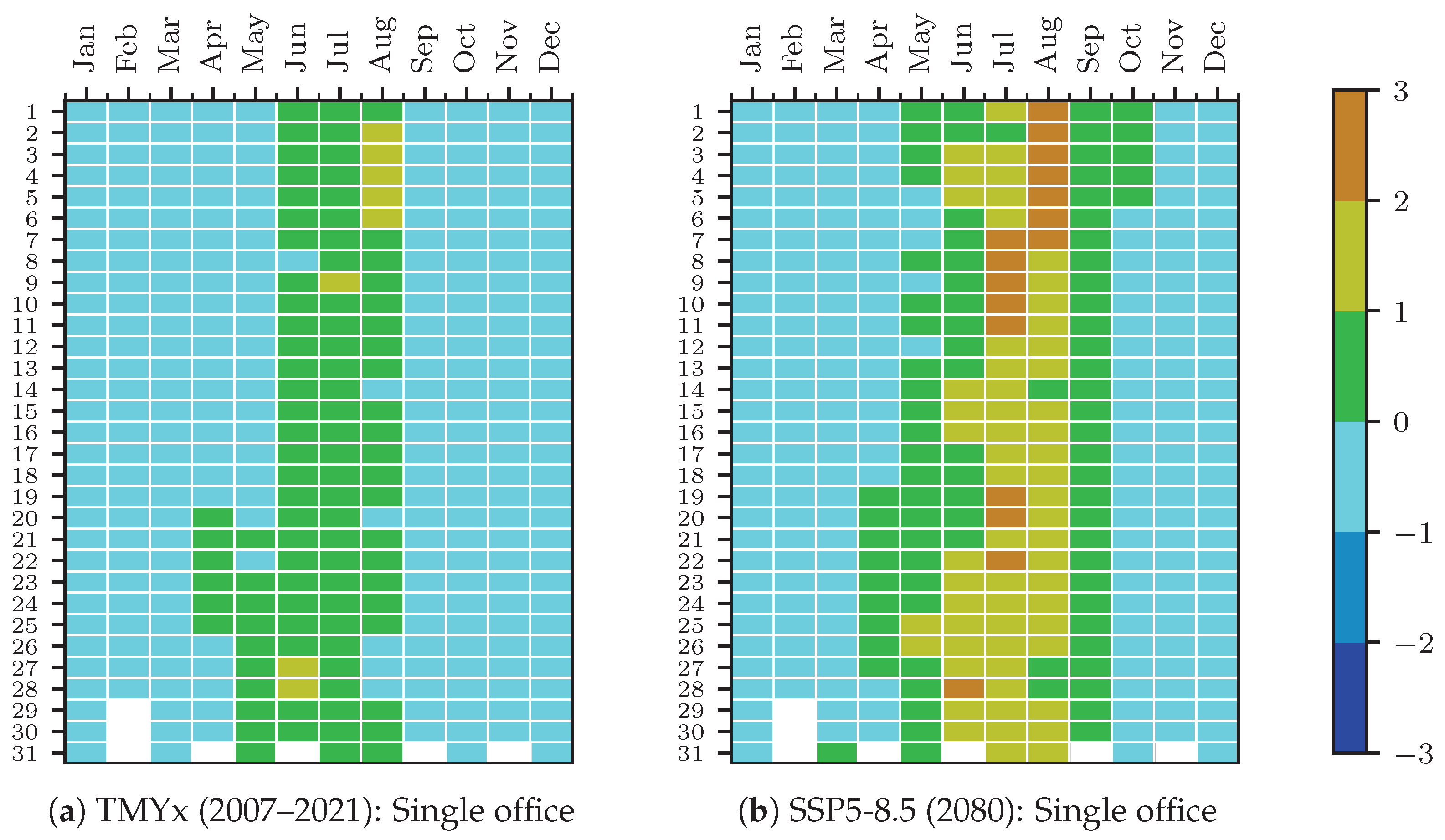
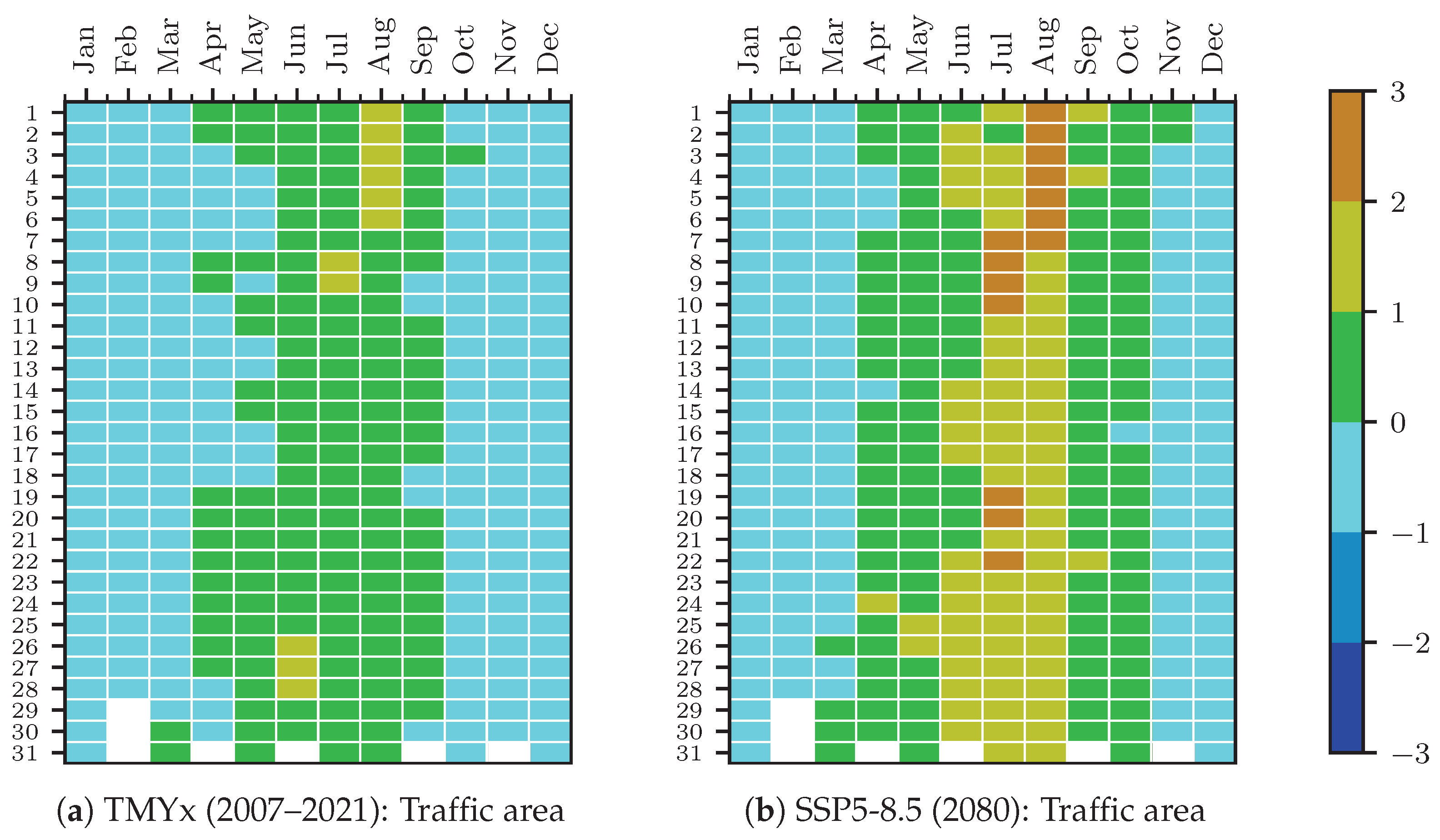
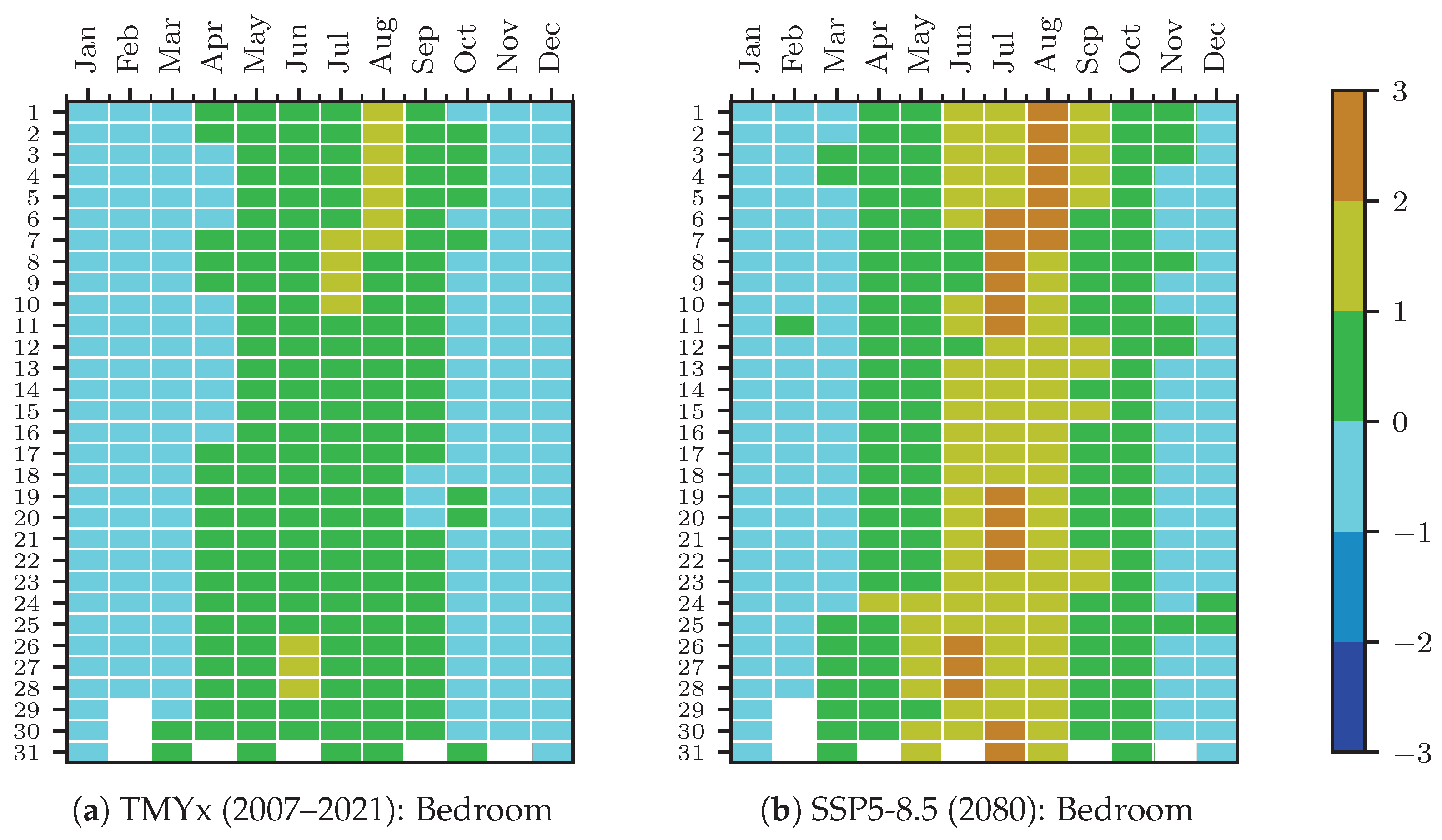
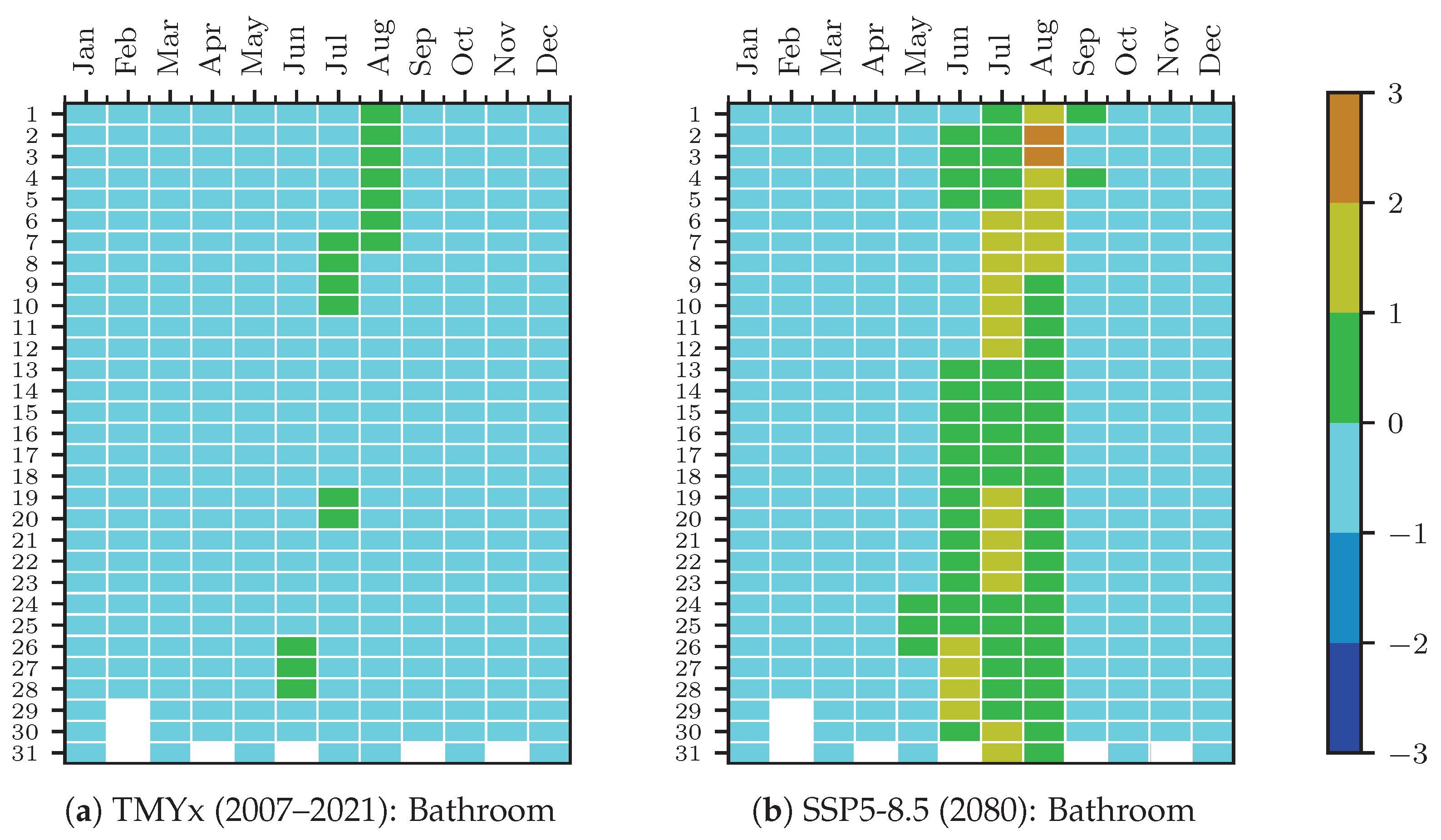
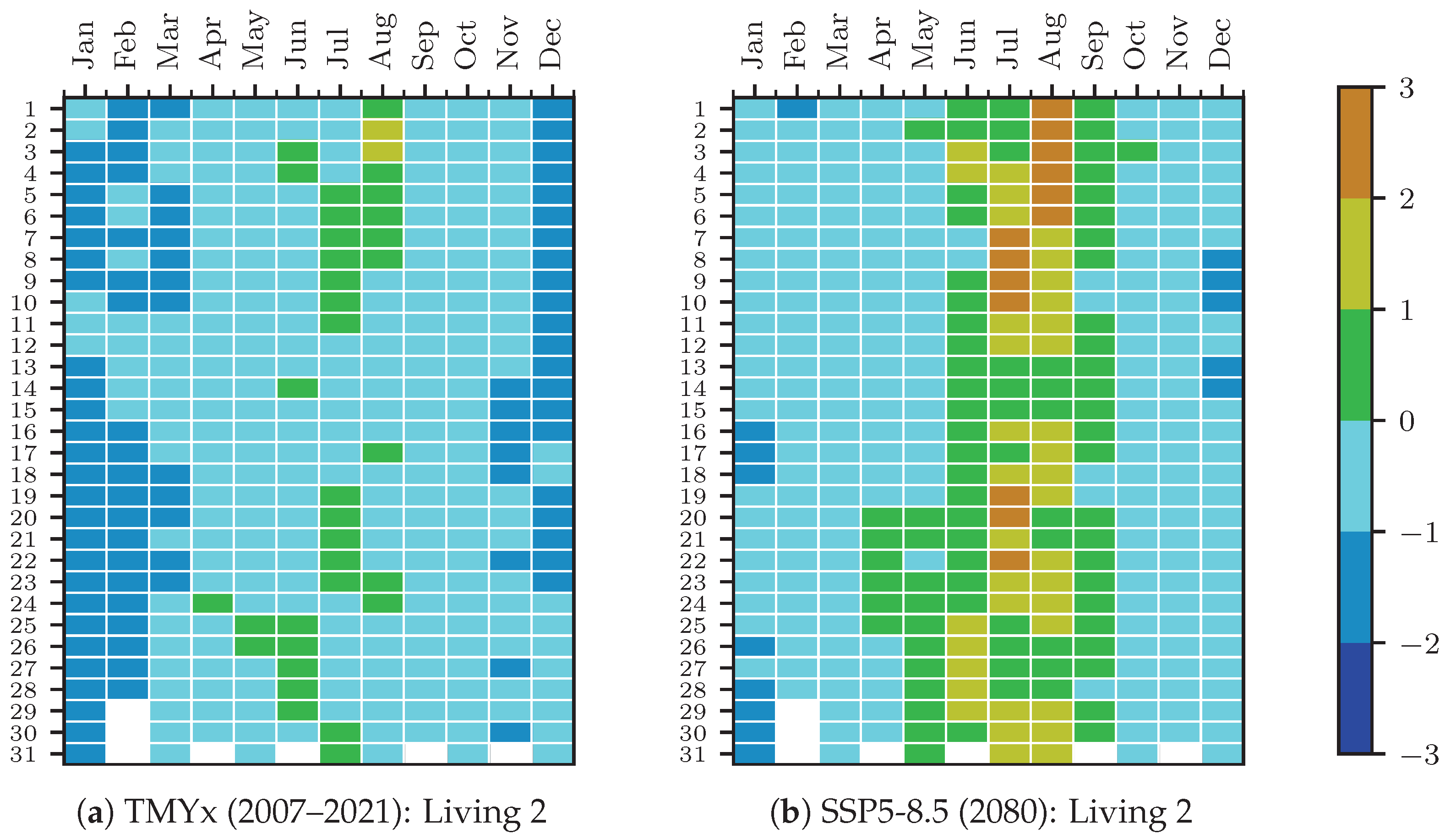
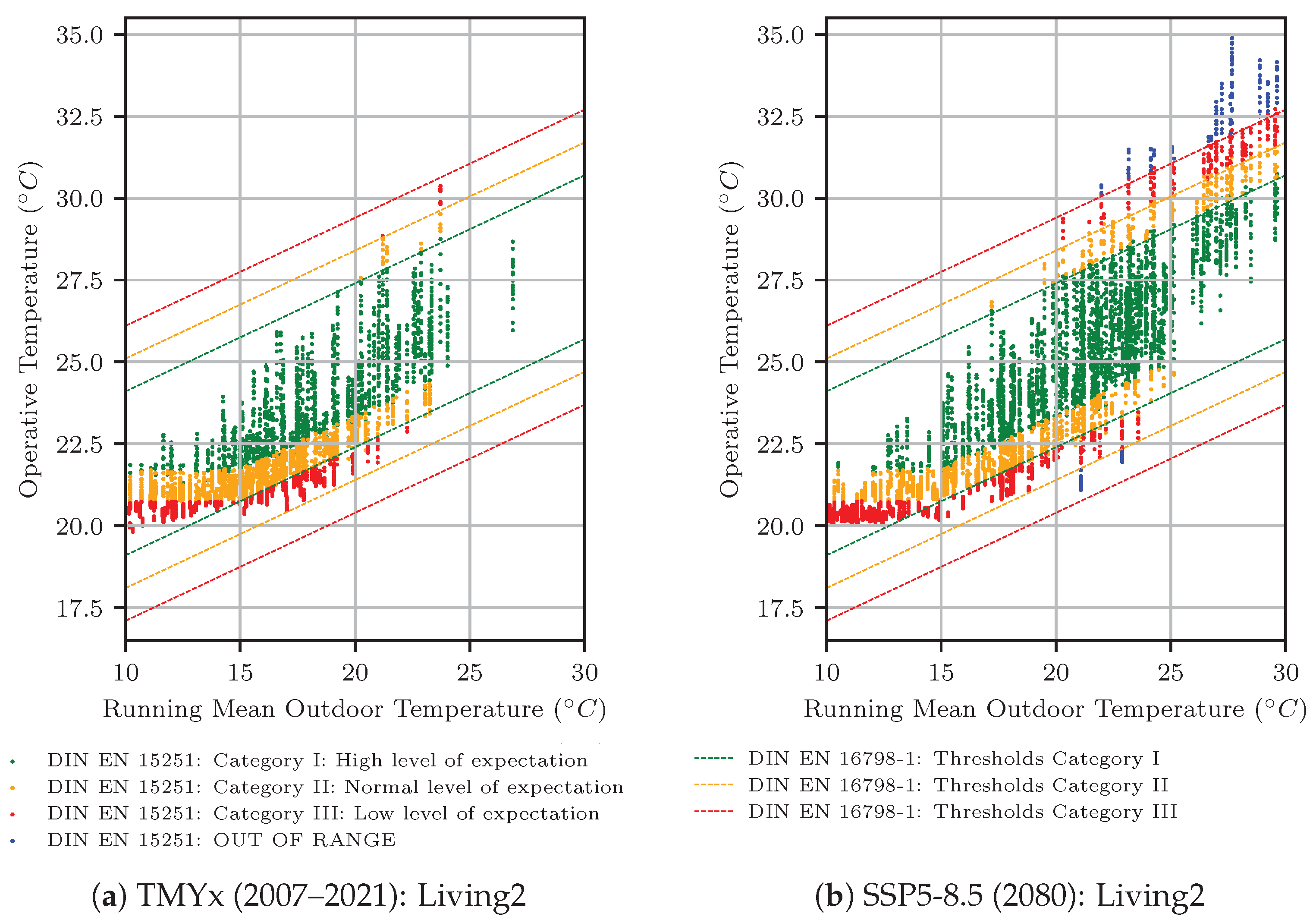
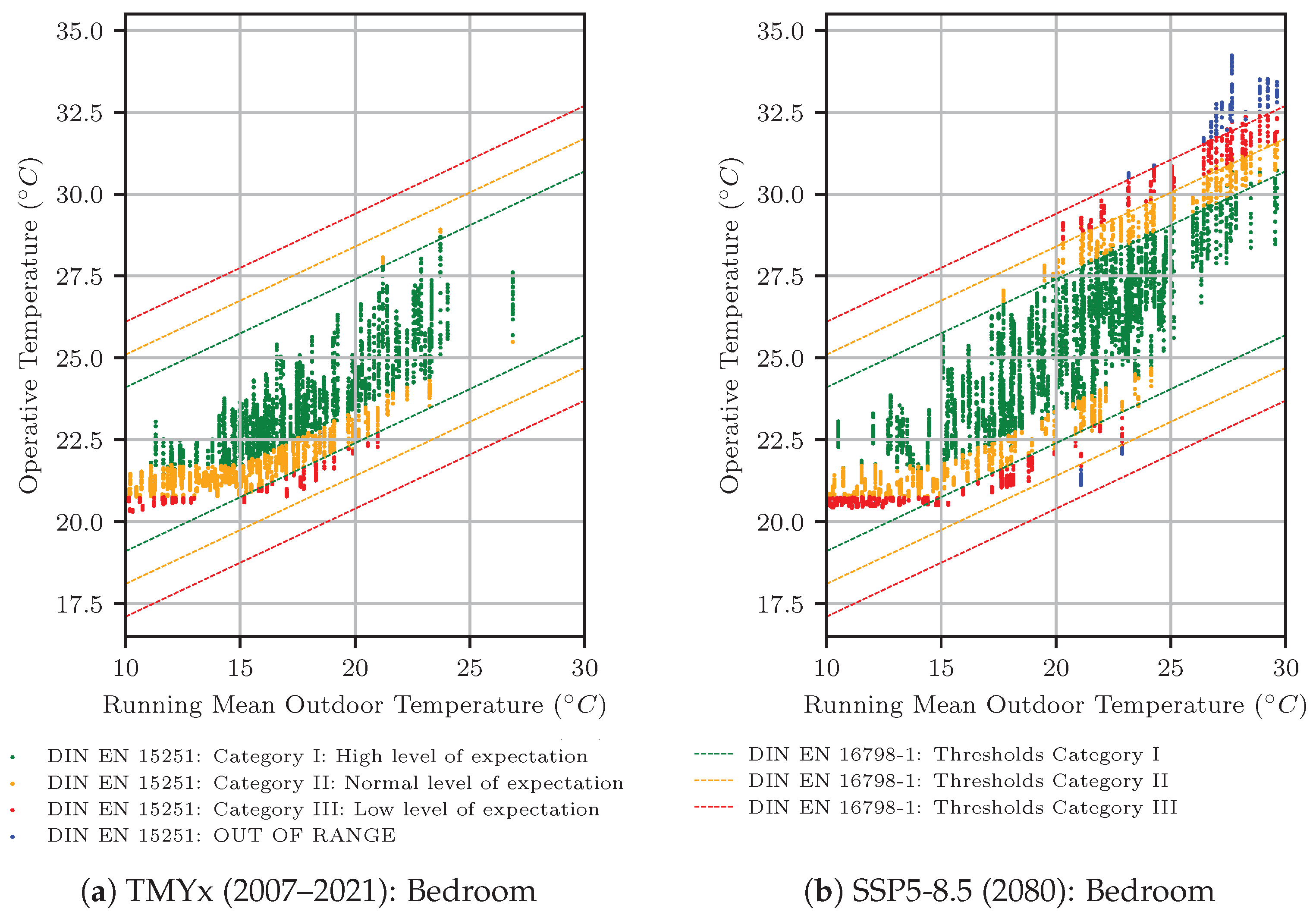
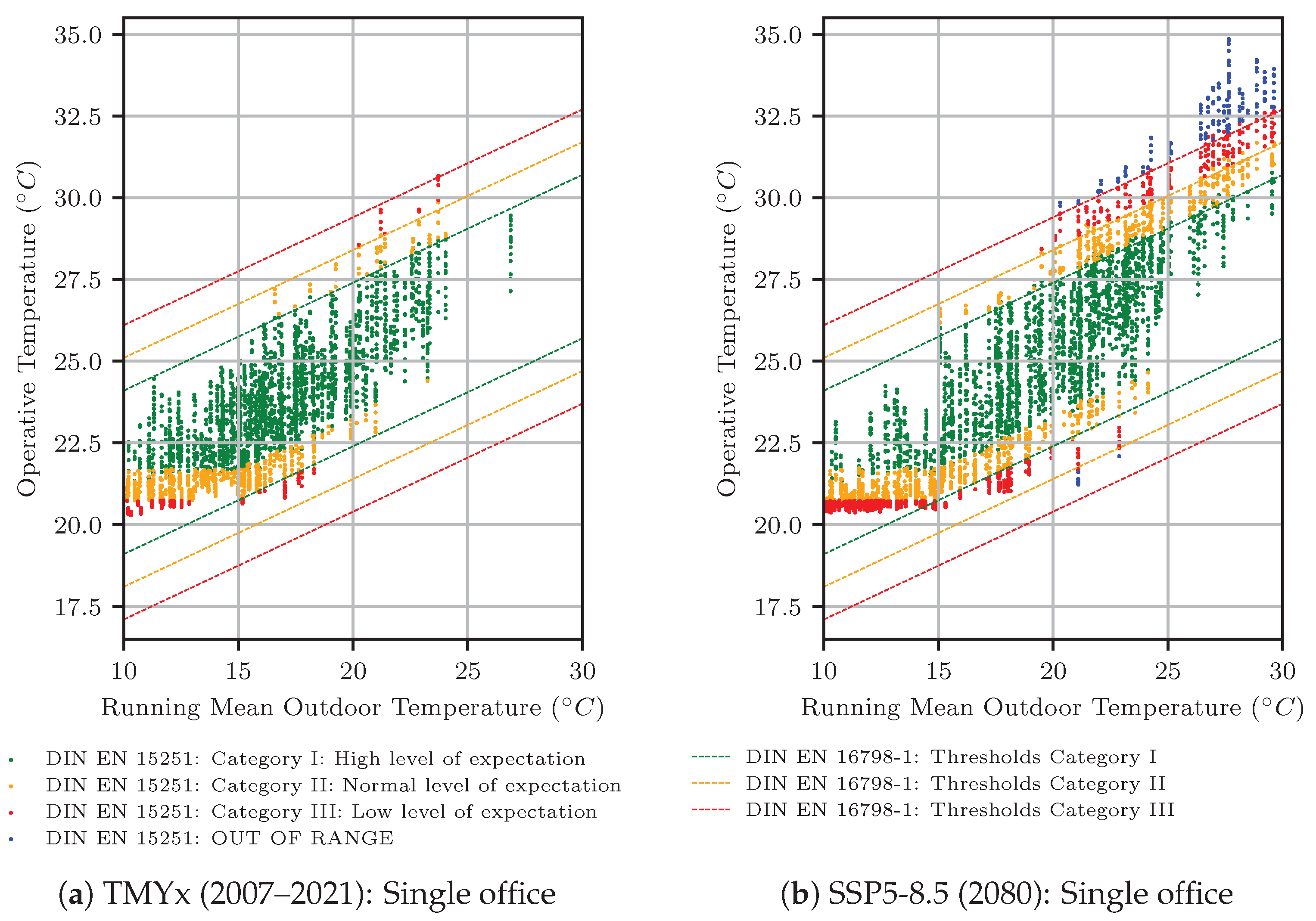
References
- Holmes, M.J.; Hacker, J.N. Climate change, thermal comfort and energy: Meeting the design challenges of the 21st century. Energy Build. 2007, 39, 802–814. [Google Scholar] [CrossRef]
- Bell, N.; Bilbao, J.; Kay, M.; Sproul, A. Future climate scenarios and their impact on heating, ventilation and air-conditioning system design and performance for commercial buildings for 2050. Renew. Sustain. Energy Rev. 2022, 162, 112363. [Google Scholar] [CrossRef]
- Klepeis, N.E.; Nelson, W.C.; Ott, W.R.; Robinson, J.P.; Tsang, A.M.; Switzer, P.; Behar, J.V.; Hern, S.C.; Engelmann, W.H. The National Human Activity Pattern Survey (NHAPS): A resource for assessing exposure to environmental pollutants. J. Expo. Sci. Environ. Epidemiol. 2001, 11, 231–252. [Google Scholar] [CrossRef] [PubMed]
- Krause, C.; Schulz, C. Aufenthaltszeiten der deutschen Bevölkerung im Innenraum, im Freien, im Straßenverkehr [German population’s time spent indoors, outdoors, in traffic]. Umweltmed. Forsch. Und Prax. 1998, 3, 249. [Google Scholar]
- Zomorodian, Z.S.; Tahsildoost, M.; Hafezi, M. Thermal comfort in educational buildings: A review article. Renew. Sustain. Energy Rev. 2016, 59, 895–906. [Google Scholar] [CrossRef]
- Antoniadou, P.; Papadopoulos, A.M. Occupants’ thermal comfort: State of the art and the prospects of personalized assessment in office buildings. Energy Build. 2017, 153, 136–149. [Google Scholar] [CrossRef]
- Andargie, M.S.; Touchie, M.; O’Brien, W. A review of factors affecting occupant comfort in multi-unit residential buildings. Build. Environ. 2019, 160, 106182. [Google Scholar] [CrossRef]
- ISO 16739; Industry Foundation Classes (IFC) for Data Sharing in the Construction and Facility Management Industries—Part 1: Data Schema. Technical Report 16739. International Organization for Standardization: Geneva, Switzerland, 2018.
- Jansen, D.; Mehrfeld, P.; Müller, D.; Fichter, E.; Richter, V.; Barz, A.; Brunkhorst, J.; Dahncke, M.; Jahangiri, P.; Warnecke, C.; et al. BIM2SIM—Development of semi-automated methods for the generation of simulation models using Building Information Modeling. In Proceedings of the Building Simulation 2021: 17th Conference of International Building Performance Simulation Association, Bruges, Belgium, 1–3 September 2021. [Google Scholar] [CrossRef]
- Müller, D.; Jansen, D.; van Treeck, C.; Fichter, E.; Richter, V.; Lüdemann, B.; Jahangiri, P.; Brunkhorst, J.; Dahnke, M.; Warnecke, C. BIM2SIM—Methodenentwicklung zur Erstellung von Simulationsmodellen aus Daten des Building Information Modeling: Gemeinsamer Endbericht: Berichtszeitraum: 1 May 2018–31 October 2021; RWTH Aachen University: Aachen, Germany, 2021. [Google Scholar] [CrossRef]
- Fanger, P.O. Thermal Comfort. Analysis and Applications in Environmental Engineering; Danish Technical Press: Copenhagen, Denmark, 1970. [Google Scholar]
- Barone, G.; Buonomano, A.; Forzano, C.; Palombo, A. Enhancing trains envelope–heating, ventilation, and air conditioning systems: A new dynamic simulation approach for energy, economic, environmental impact and thermal comfort analyses. Energy 2020, 204, 117833. [Google Scholar] [CrossRef]
- Limane, A.; Fellouah, H.; Galanis, N. Three-dimensional OpenFOAM simulation to evaluate the thermal comfort of occupants, indoor air quality and heat losses inside an indoor swimming pool. Energy Build. 2018, 167, 49–68. [Google Scholar] [CrossRef]
- Luo, M.; Guo, J.; Feng, X.; Chen, W. Studying occupant’s heat exposure and thermal comfort in the kitchen through full-scale experiments and CFD simulations. Indoor Built Environ. 2023, 32, 928–943. [Google Scholar] [CrossRef]
- Li, G.; Chi, L.; Guo, J.; Liu, C.; Luo, Y.; She, C. Numerical simulation on indoor thermal comfort of a new integrated rural heating system. Procedia Eng. 2015, 121, 1111–1117. [Google Scholar] [CrossRef]
- Mahecha Zambrano, J.; Filippi Oberegger, U.; Salvalai, G. Towards integrating occupant behaviour modelling in simulation-aided building design: Reasons, challenges and solutions. Energy Build. 2021, 253, 111498. [Google Scholar] [CrossRef]
- Gritzki, R.; Rösler, M. Komfort für Passivhaus-Büros- Planungsunterstützung mit Hilfe gekoppelter Gebäude-, Anlagen-und Strömungssimulation. Bauphysik 2013, 35, 8–15. [Google Scholar] [CrossRef]
- Barbosa, R.; Vicente, R.; Santos, R. Climate change and thermal comfort in Southern Europe housing: A case study from Lisbon. Build. Environ. 2015, 92, 440–451. [Google Scholar] [CrossRef]
- Escandón, R.; Suárez, R.; Sendra, J.J.; Ascione, F.; Bianco, N.; Mauro, G.M. Predicting the impact of climate change on thermal comfort in a building category: The Case of Linear-type Social Housing Stock in Southern Spain. Energies 2019, 12, 2238. [Google Scholar] [CrossRef]
- Yan, H.; Ji, G.; Yan, K. Data-driven prediction and optimization of residential building performance in Singapore considering the impact of climate change. Build. Environ. 2022, 226, 109735. [Google Scholar] [CrossRef]
- Siu, C.Y.; O’Brien, W.; Touchie, M.; Armstrong, M.; Laouadi, A.; Gaur, A.; Jandaghian, Z.; Macdonald, I. Evaluating thermal resilience of building designs using building performance simulation—A review of existing practices. Build. Environ. 2023, 234, 110124. [Google Scholar] [CrossRef]
- Katavoutas, G.; Founda, D.; Kitsara, G.; Giannakopoulos, C. Climate change and thermal comfort in top tourist destinations—The case of Santorini (Greece). Sustainability 2021, 13, 9107. [Google Scholar] [CrossRef]
- Mahadevia, D.; Pathak, M.; Bhatia, N.; Patel, S. Climate Change, Heat Waves and Thermal Comfort—Reflections on Housing Policy in India. Environ. Urban. ASIA 2020, 11, 29–50. [Google Scholar] [CrossRef]
- Thapa, S.; Rijal, H.B.; Pasut, W.; Singh, R.; Indraganti, M.; Bansal, A.K.; Panda, G.K. Simulation of thermal comfort and energy demand in buildings of sub-Himalayan eastern India-Impact of climate change at mid (2050) and distant (2080) future. J. Build. Eng. 2023, 68, 106068. [Google Scholar] [CrossRef]
- ASHRAE Standard 55. ANSI/ASHRAE Standard 55: Thermal Environmental Conditions for Human Occupancy; Technical report; ASHRAE Special Publications: Peachtree Corners, GA, USA, 2017. [Google Scholar]
- ISO 7730; Ergonomics of the Thermal Environment—Analytical Determination and Interpretation of Thermal Comfort Using Calculation of the PMV and PPD Indices and Local Thermal Comfort Criteria. International Organization for Standardization: Geneva, Switzerland, 2005.
- Van Hoof, J. Forty years of Fanger’s model of thermal comfort: Comfort for all? Indoor Air 2008, 18, 182–201. [Google Scholar] [CrossRef] [PubMed]
- Charef, R.; Emmitt, S.; Alaka, H.; Fouchal, F. Building Information Modelling adoption in the European Union: An overview. J. Build. Eng. 2019, 25, 100777. [Google Scholar] [CrossRef]
- Ying, H.; Lee, S. A rule-based system to automatically validate IFC second-level space boundaries for building energy analysis. Autom. Constr. 2021, 127, 103724. [Google Scholar] [CrossRef]
- Richter, V.; Malhotra, A.; Fichter, E.; Hochberger, A.; Frisch, J.; van Treeck, C. Validation of IFC-based Geometric Input for Building Energy Performance Simulation. In Proceedings of the 2022 Building Performance Modeling Conference and SimBuild Co-Organized by ASHRAE and IBPSA-USA, Chicago, IL, USA, 14–16 September 2022. [Google Scholar] [CrossRef]
- Di Biccari, C.; Calcerano, F.; D’Uffizi, F.; Esposito, A.; Campari, M.; Gigliarelli, E. Building information modeling and building performance simulation interoperability: State-of-the-art and trends in current literature. Adv. Eng. Inform. 2022, 54, 101753. [Google Scholar] [CrossRef]
- Bazjanac, V. Space Boundary Requirements for Modeling of Building Geometry for Energy and Other Performance Simulation. In Proceedings of the CIB W78 2010: 27th International Conference, Cairo, Egypt, 16–18 November 2010; International Council for Research and Innovation in Building and Construction: Kanata, ON, Canada, 2010. [Google Scholar]
- van Treeck, C.; Rank, E. Dimensional reduction of 3D building models using graph theory and its application in building energy simulation. Eng. Comput. 2007, 23, 109–122. [Google Scholar] [CrossRef]
- Rose, C.M.; Bazjanac, V. An algorithm to generate space boundaries for building energy simulation. Eng. Comput. 2015, 31, 271–280. [Google Scholar] [CrossRef]
- Jones, N.L.; McCrone, C.J.; Walter, B.J.; Pratt, K.B.; Greenberg, D.P. Automated Translation and Thermal Zoning of Digital Building Models for Energy Analysis. In Proceedings of the BS2013: 13th Conference of International Building Performance Simulation Association, Chambéry, France, 26–28 August 2013. [Google Scholar]
- Lilis, G.N.; Giannakis, G.I.; Rovas, D.V. Automatic generation of second-level space boundary topology from IFC geometry inputs. Autom. Constr. 2017, 76, 108–124. [Google Scholar] [CrossRef]
- Ying, H.; Lee, S. Generating second-level space boundaries from large-scale IFC-compliant building information models using multiple geometry representations. Autom. Constr. 2021, 126, 103659. [Google Scholar] [CrossRef]
- Fichter, E.; Richter, V.; Frisch, J.; van Treeck, C. Automatic generation of second level space boundary geometry from IFC models. In Proceedings of the Building Simulation 2021: 17th Conference of International Building Performance Simulation Association, Bruges, Belgium, 1–3 September 2021. [Google Scholar] [CrossRef]
- Mediavilla, A.; Elguezabal, P.; Lasarte, N. Graph-Based methodology for Multi-Scale generation of energy analysis models from IFC. Energy Build. 2023, 282, 112795. [Google Scholar] [CrossRef]
- Giannakis, G.I.; Katsigarakis, K.I.; Lilis, G.N.; Rovas, D.V. A Workflow for Automated Building Energy Performance Model Generation Using BIM. In Proceedings of the Building Simulation 2019; Corrado, V., Ed.; International Building Performance Simulation Association: Rome, Italy, 2019. [Google Scholar]
- Nytsch-Geusen, C.; Rädler, J.; Thorade, M.; Ribas Tugores, C. BIM2Modelica—An open source toolchain for generating and simulating thermal multi-zone building models by using structured data from BIM models. In Proceedings of the 13th International Modelica Conference, Regensburg, Germany, 4–6 March 2019; Linköing University Electronic Press: Linköing, Sweden, 2019; pp. 33–38. [Google Scholar] [CrossRef]
- O’Donnell, J.; See, R.; Rose, C.; Maile, T.; Bazjanac, V. SimModel: A domain data model for whole building energy simulation. In Proceedings of the Building Simulation 2011: 12th Conference of International Building Performance Simulation Association, Sydney, Australia, 14–16 November 2011. [Google Scholar]
- Andriamamonjy, A.; Saelens, D.; Klein, R. An automated IFC-based workflow for building energy performance simulation with Modelica. Autom. Constr. 2018, 91, 166–181. [Google Scholar] [CrossRef]
- Cao, J. SimModel Transformation Middleware for Modelica-based Building Energy Modeling and Simulation. Ph.D. Thesis, RWTH Aachen University, Aachen, Germany, 2018. [Google Scholar]
- Chen, Z.; Deng, Z.; Chong, A.; Chen, Y. AutoBPS-BIM: A toolkit to transfer BIM to BEM for load calculation and chiller design optimization. Build. Simul. 2023. [Google Scholar] [CrossRef]
- Remmen, P.; Lauster, M.; Mans, M.; Fuchs, M.; Osterhage, T.; Müller, D. TEASER: An open tool for urban energy modelling of building stocks. J. Build. Perform. Simul. 2018, 11, 84–98. [Google Scholar] [CrossRef]
- DIN V 18599-10; Energy Efficiency of Buildings—Calculation of the Net, Final and Primary Energy Demand for Heating, Cooling, Ventilation, Domestic Hot Water and Lighting—Part 10: Boundary Conditions of Use, Climatic Data. Deutsches Institut für Normung: Berlin, Germany, September 2018.
- VDI 2078; Calculation of Thermal Loads and Room Temperatures (Design Cooling Load and Annual Simulation). Verein Deutscher Ingenieure: Düsseldorf, Germany, June 2015.
- SIA 2024; Standard-Nutzungsbedingungen für die Energie- und Gebäudetechnik. Schweizerischer Ingenieur- und Architektenverein (SIA) (engl. Swiss Society of Engineers and Architects): Zürich, Switzerland, 2006.
- Jentsch, M.F.; James, P.A.; Bourikas, L.; Bahaj, A.S. Transforming existing weather data for worldwide locations to enable energy and building performance simulation under future climates. Renew. Energy 2013, 55, 514–524. [Google Scholar] [CrossRef]
- Tapiador, F.J.; Navarro, A.; Moreno, R.; Sánchez, J.L.; García-Ortega, E. Regional climate models: 30 years of dynamical downscaling. Atmos. Res. 2020, 235, 104785. [Google Scholar] [CrossRef]
- Wilby, R.L.; Wigley, T. Downscaling general circulation model output: A review of methods and limitations. Prog. Phys. Geogr. Earth Environ. 1997, 21, 530–548. [Google Scholar] [CrossRef]
- Belcher, S.E.; Hacker, J.N.; Powell, D.S. Constructing design weather data for future climates. Build. Serv. Eng. Res. Technol. 2005, 26, 49–61. [Google Scholar] [CrossRef]
- Zeng, Z.; Kim, J.H.; Tan, H.; Hu, Y.; Rastogi, P.; Wang, J.; Muehleisen, R. A critical analysis of future weather data for building and energy modeling. In Proceedings of the Building Simulation 2023: 18th Conference of IBPSA, Shanghai, China, 4–6 September 2023. [Google Scholar]
- Nielsen, C.N.; Kolarik, J. Utilization of Climate Files Predicting Future Weather in Dynamic Building Performance Simulation—A review. J. Phys. Conf. Ser. 2021, 2069, 012070. [Google Scholar] [CrossRef]
- Rodrigues, E.; Fernandes, M.S.; Carvalho, D. Future weather generator for building performance research: An open-source morphing tool and an application. Build. Environ. 2023, 233, 110104. [Google Scholar] [CrossRef]
- Jiang, A.; Liu, X.; Czarnecki, E.; Zhang, C. Hourly weather data projection due to climate change for impact assessment on building and infrastructure. Sustain. Cities Soc. 2019, 50, 101688. [Google Scholar] [CrossRef]
- Hong, T.; Malik, J.; Krelling, A.; O’Brien, W.; Sun, K.; Lamberts, R.; Wei, M. Ten questions concerning thermal resilience of buildings and occupants for climate adaptation. Build. Environ. 2023, 244, 110806. [Google Scholar] [CrossRef]
- DIN EN 15251; Indoor Environmental Input Parameters for Design and Assessment of Energy Performance of Buildings Addressing Indoor Air Quality, Thermal Environment, Lighting and Acoustics, German Version. Deutsches Institut für Normung: Berlin, Germany, December 2012.
- DIN EN 16798-1; Energy Performance of Buildings—Ventilation for Buildings—Part 1: Indoor Environmental Input Parameters for Design and Assessment of Energy Performance of Buildings Addressing Indoor Air Quality, Thermal Environment, Lighting and Acoustics—Module M1-6, German Version. Deutsches Institut für Normung: Berlin, Germany, March 2022.
- Richter, V.; Lorenz, C.L.; Syndicus, M.; Frisch, J.; van Treeck, C. Framework for automated IFC-based thermal comfort analysis based on IFC model maturity. In Proceedings of the Building Simulation 2023: 18th Conference of IBPSA, Shanghai, China, 4–6 September 2023. (to be published). [Google Scholar]
- 2017 ASHRAE Handbook: Fundamentals, si ed.; ASHRAE: Atlanta, GA, USA, 2017.
- DIN EN ISO 8996; Ergonomics of the Thermal Environment—Determination of Metabolic Rate (ISO 8996:2021); German Version. Deutsches Institut für Normung: Berlin, Germany, October 2022.
- DIN EN ISO 9920; Ergonomics of the Thermal Environment—Estimation of Thermal Insulation and Water Vapour Resistance of a Clothing Ensemble (ISO 9920:2007, Corrected version 2008-11-01); German Version. Deutsches Institut für Normung: Berlin, Germany, October 2009.
- Zhang, N.; Cao, B.; Zhu, Y. An effective method to determine bedding system insulation based on measured data. Build. Simul. 2023, 16, 121–132. [Google Scholar] [CrossRef]
- EC-Earth Consortium. EC-Earth-Consortium EC-Earth3 model output prepared for CMIP6 CMIP. [CrossRef]
- Mitra, D.; Steinmetz, N.; Chu, Y.; Cetin, K.S. Typical occupancy profiles and behaviors in residential buildings in the United States. Energy Build. 2020, 210, 109713. [Google Scholar] [CrossRef]
- Elnagar, E.; Gendebien, S.; Georges, E.; Berardi, U.; Doutreloup, S.; Lemort, V. Framework to assess climate change impact on heating and cooling energy demands in building stock: A case study of Belgium in 2050 and 2100. Energy Build. 2023, 298, 113547. [Google Scholar] [CrossRef]

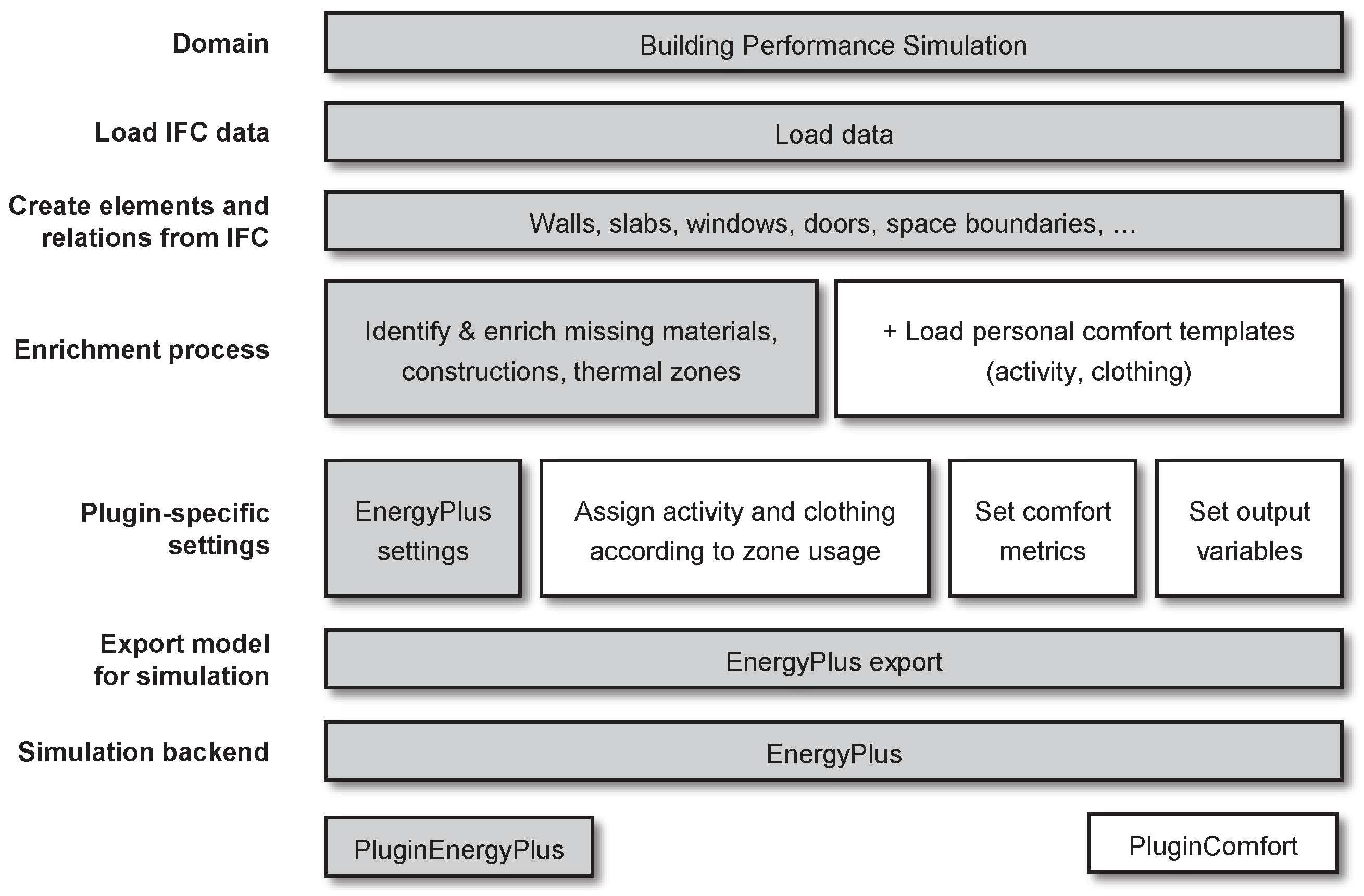

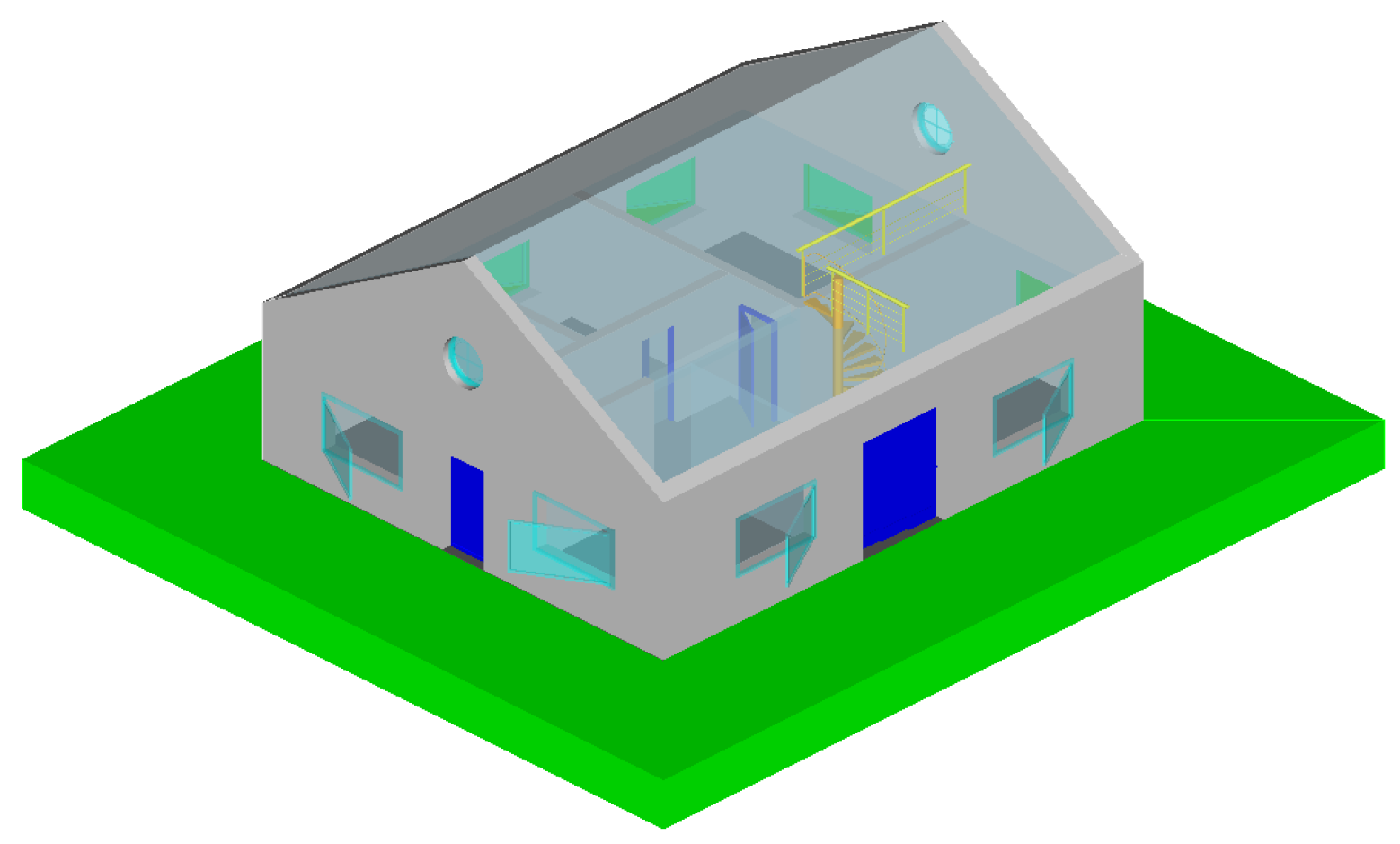
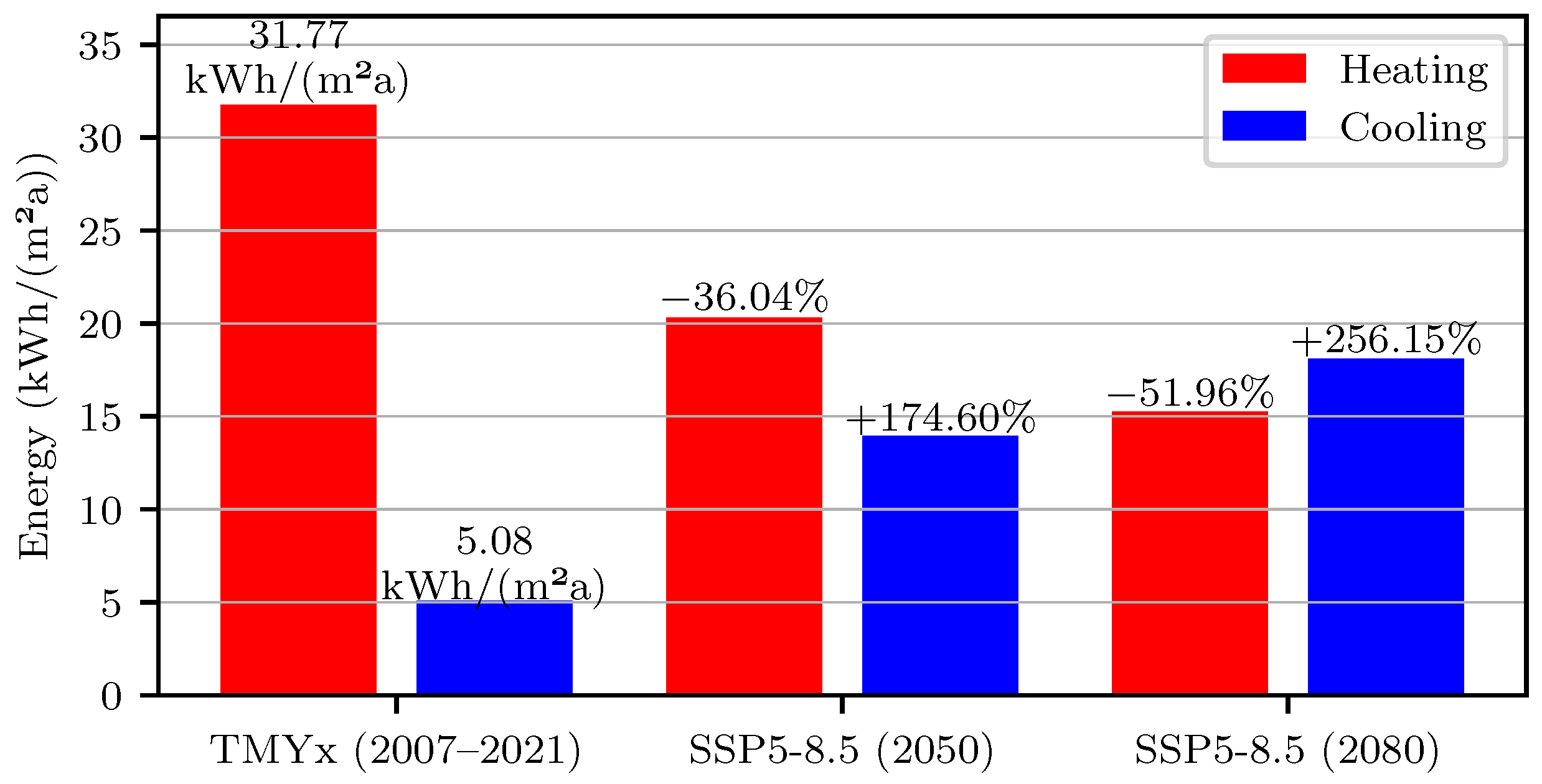



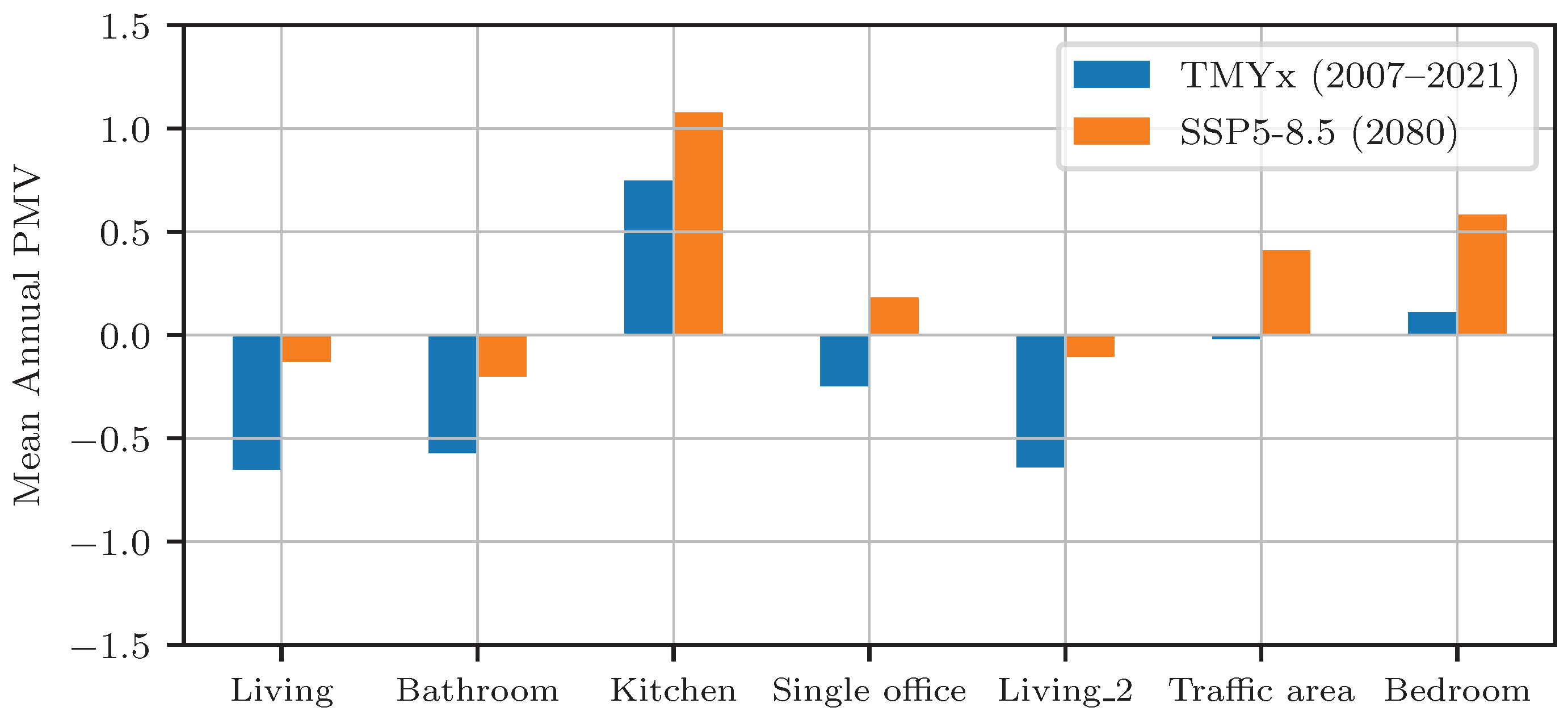
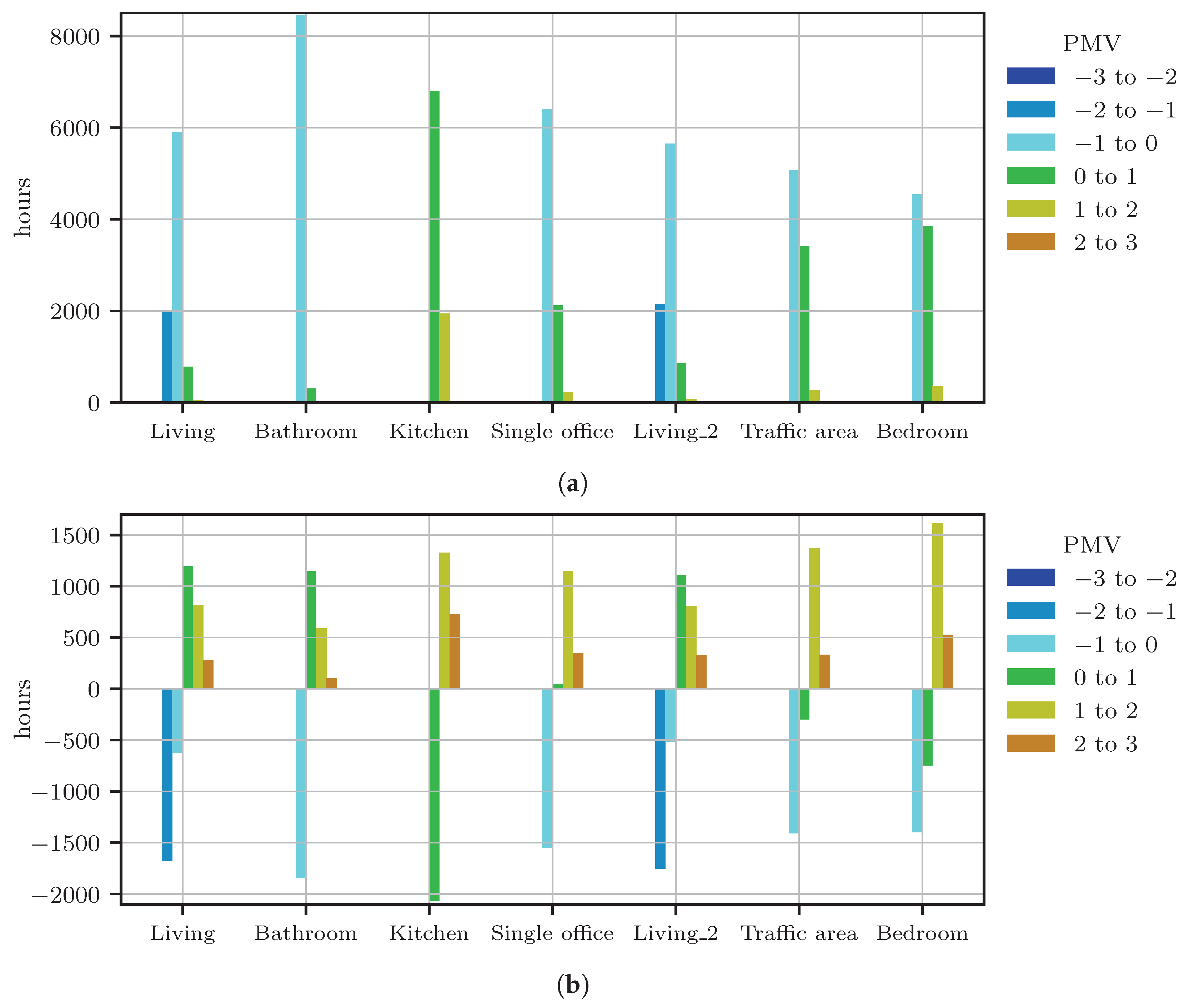
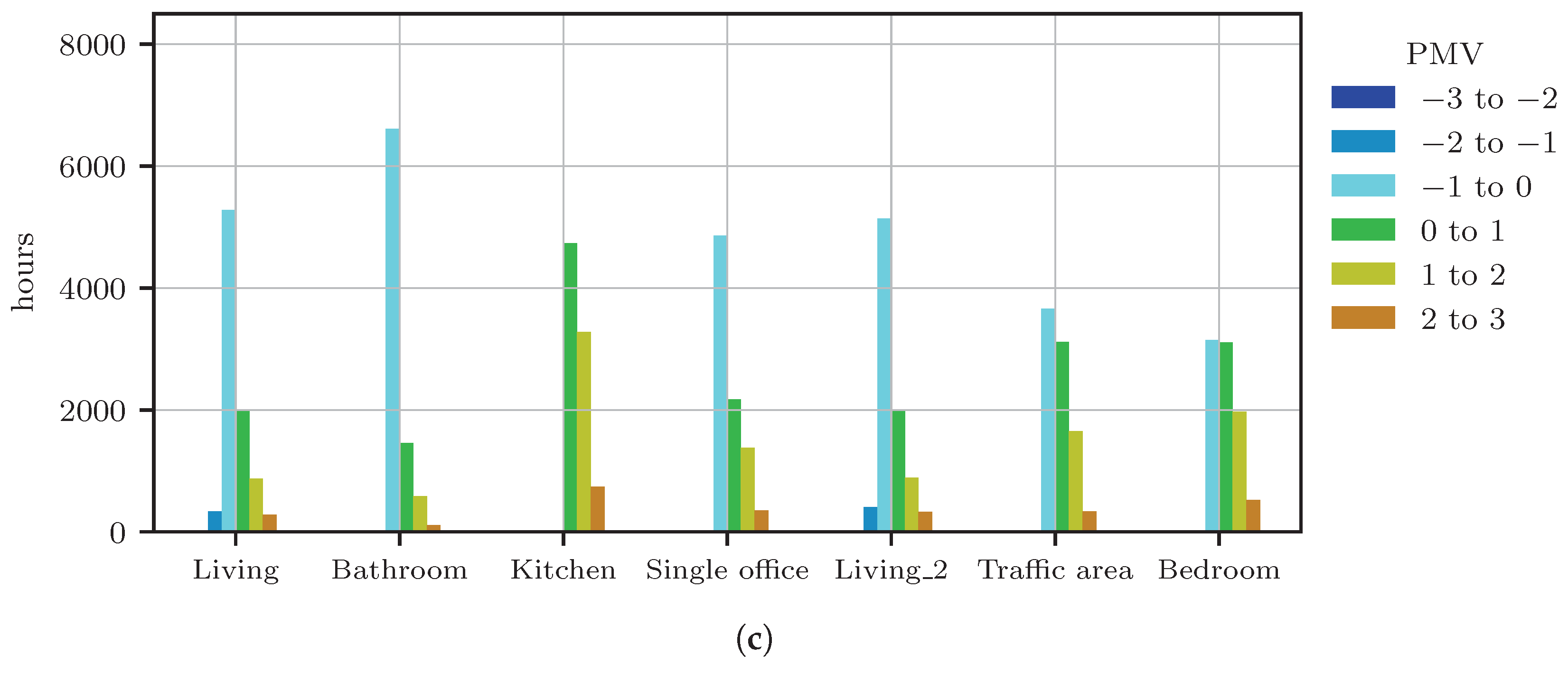
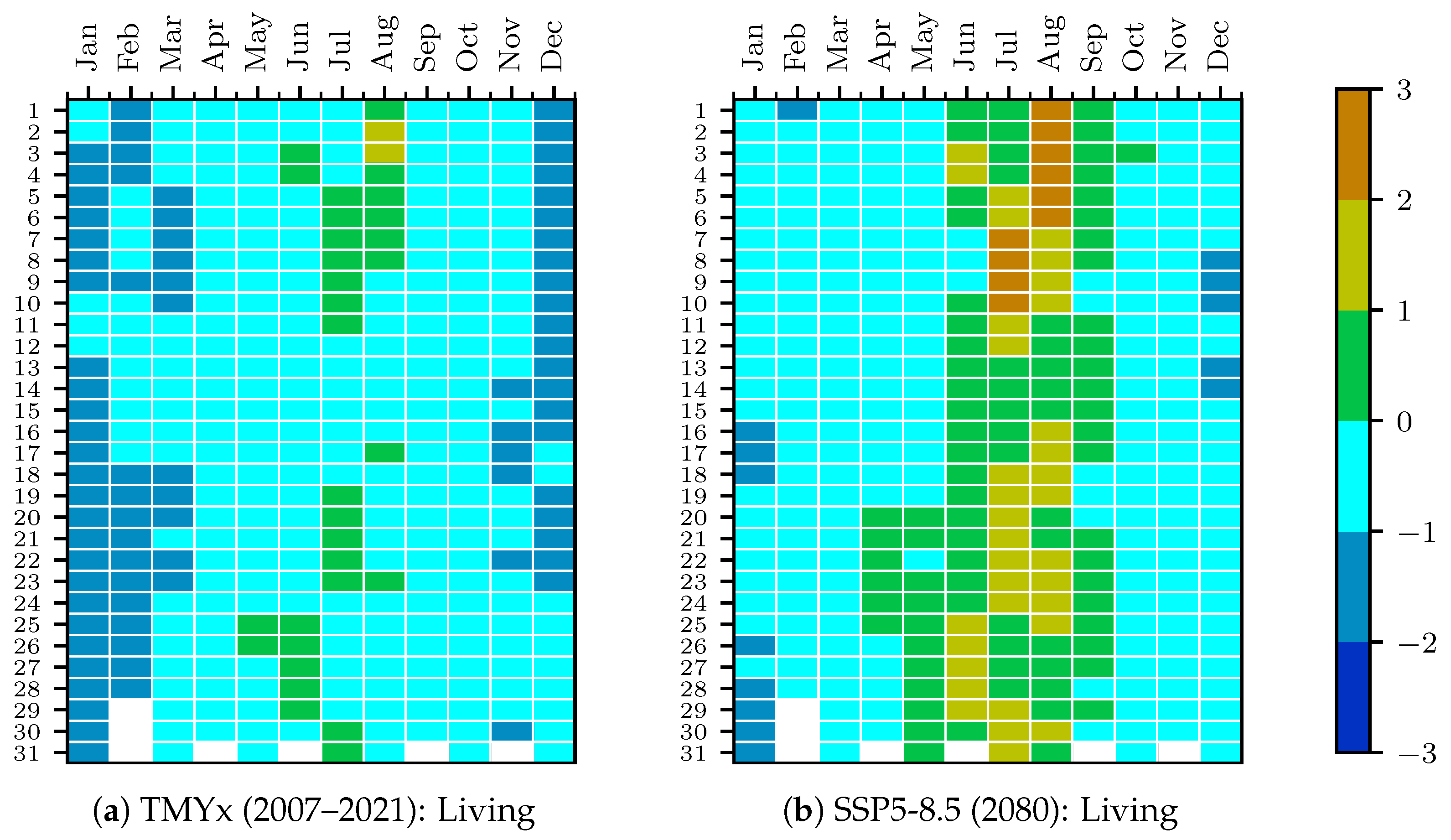
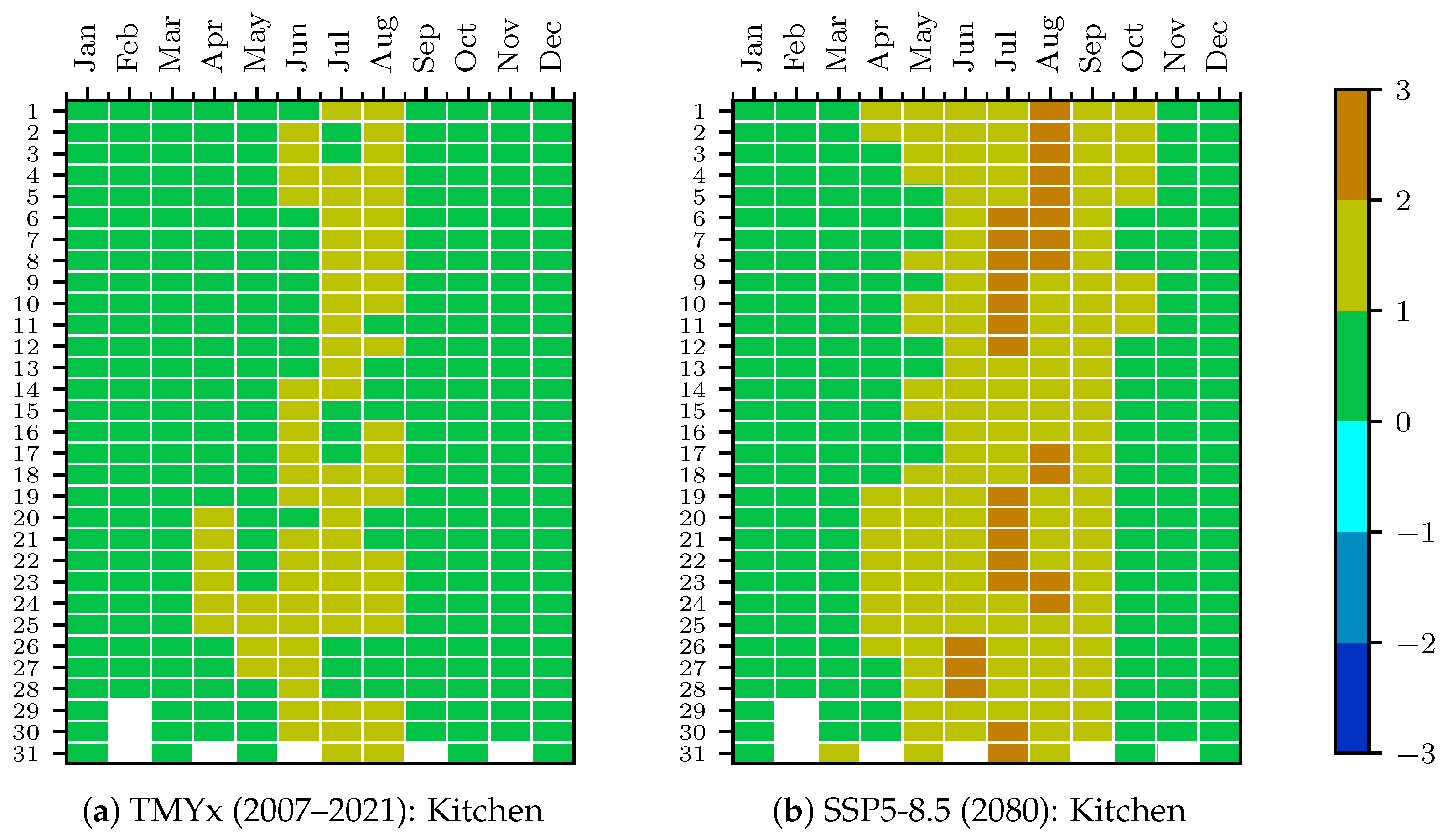
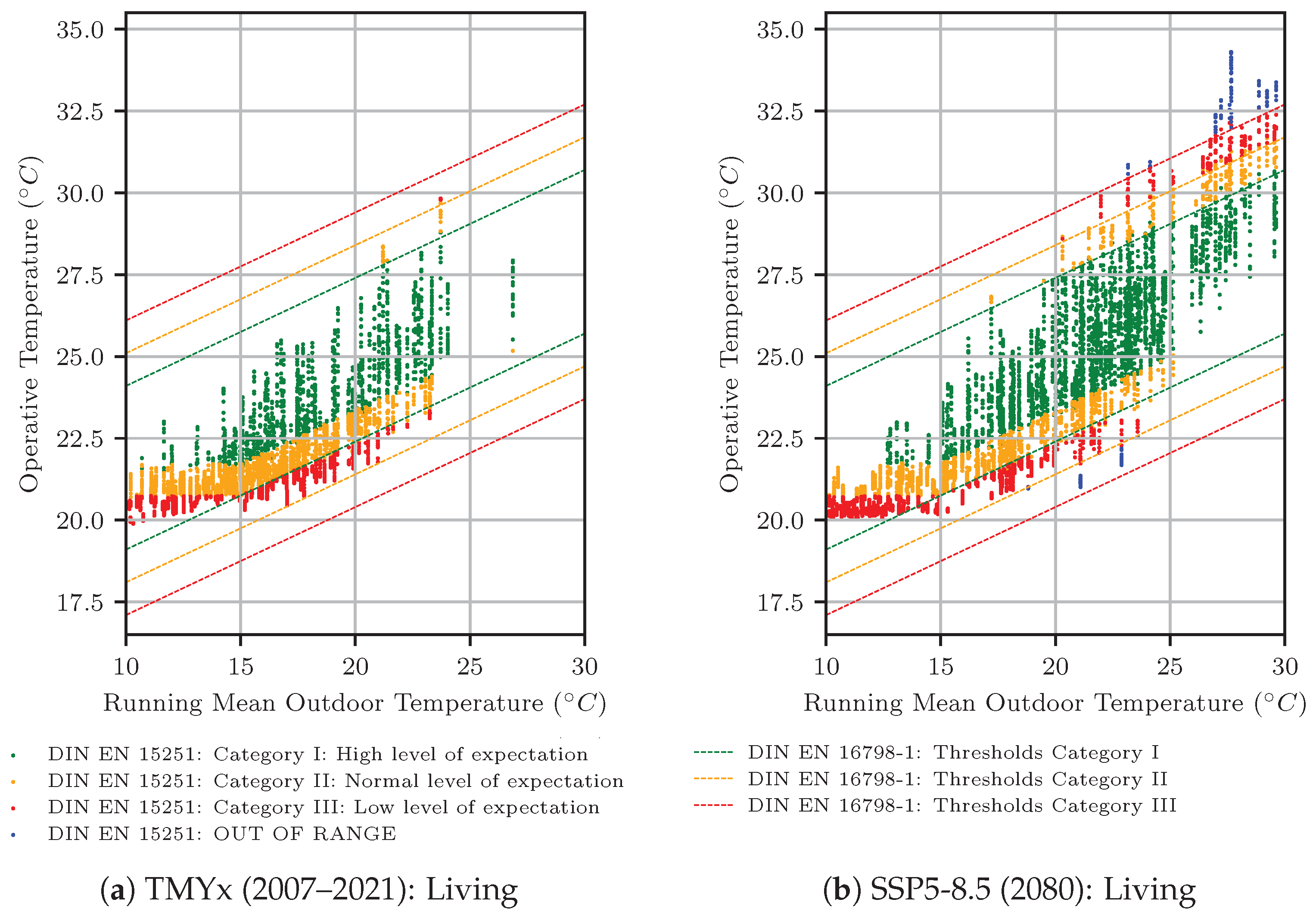
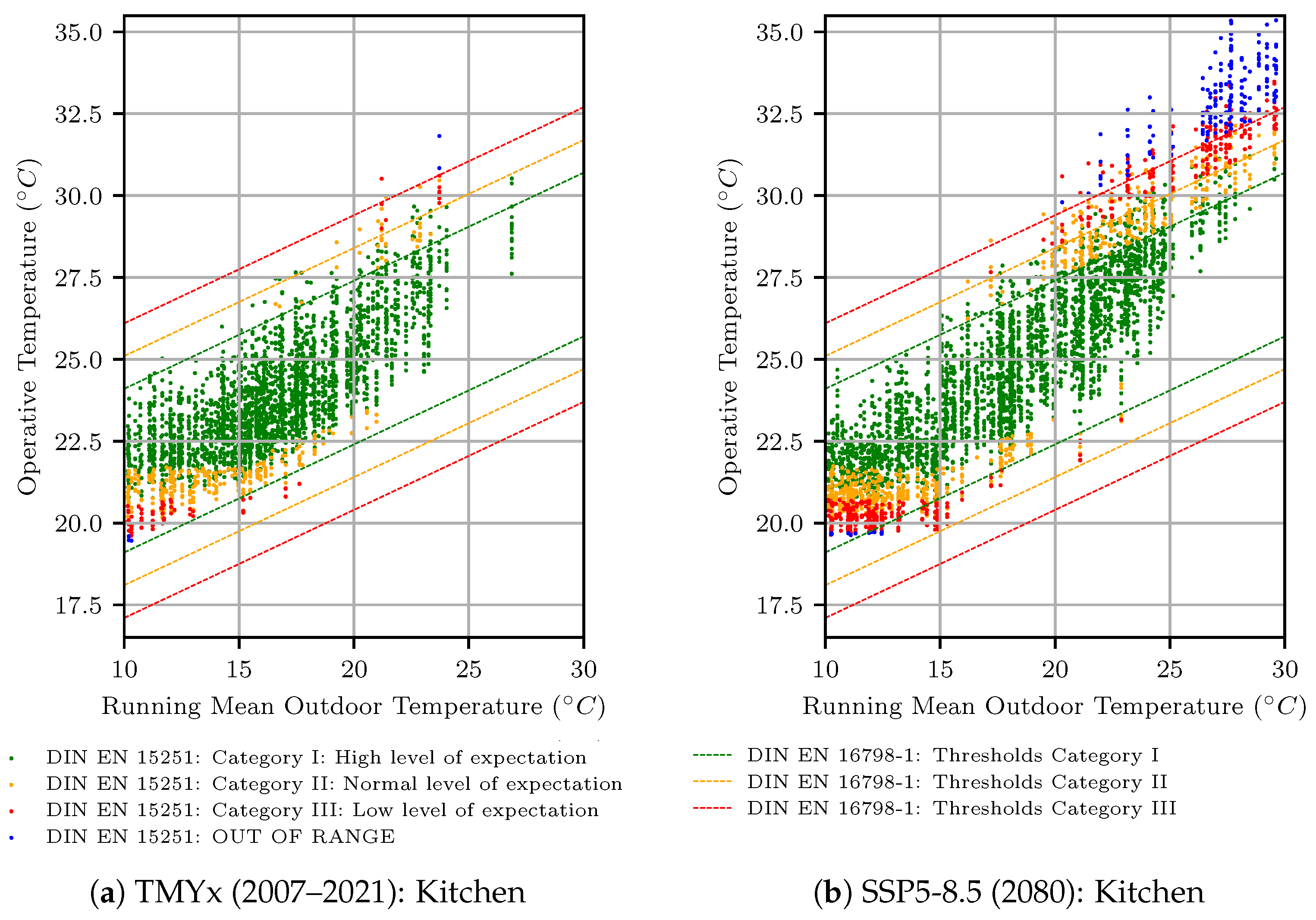
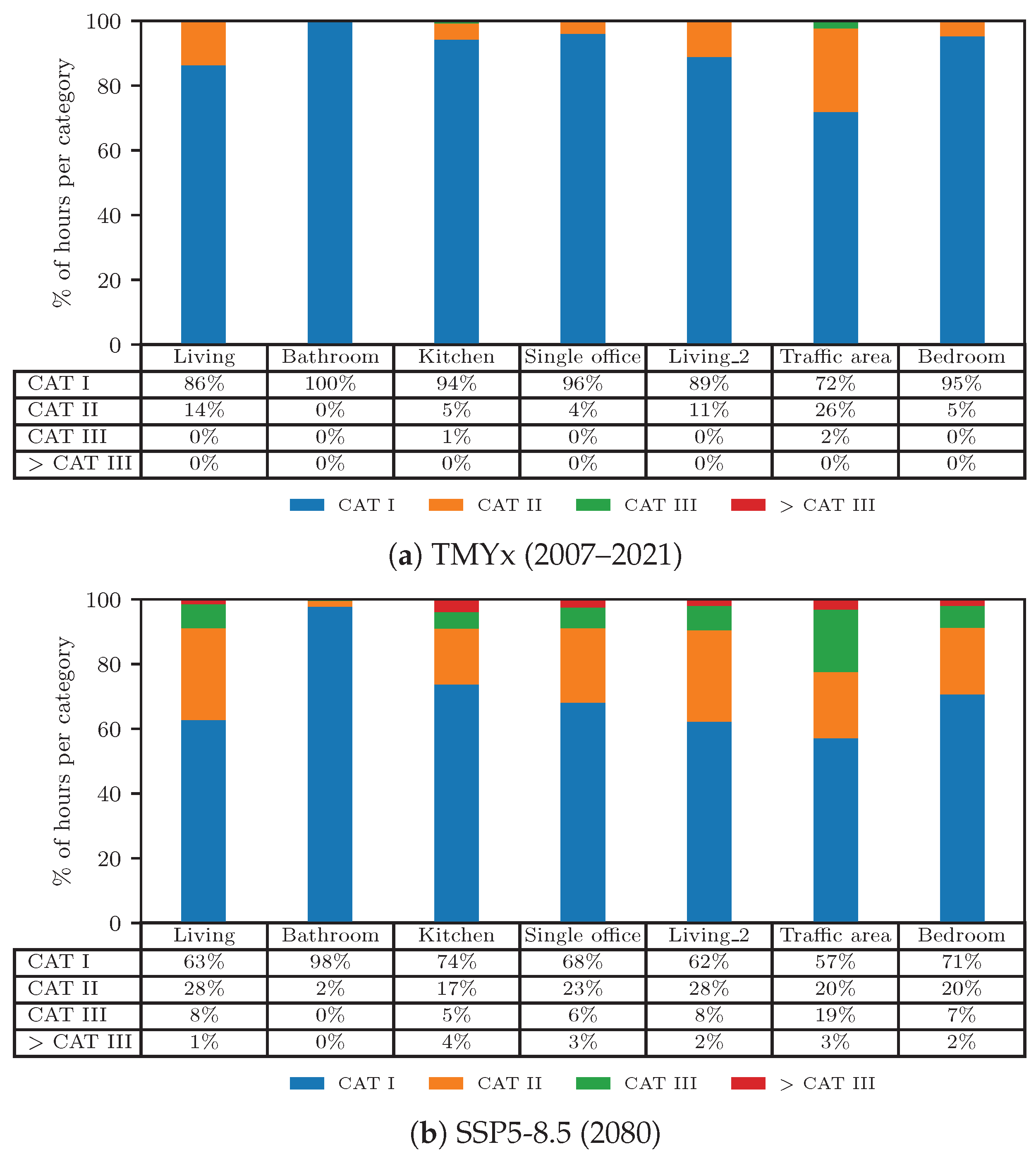
| DIN EN 15251 | DIN EN 16798-1 | |
|---|---|---|
| Category I, upper threshold | 24.1…30.7 °C | |
| Category I, lower threshold | 21.75…26.7 °C | 19.1…25.7 °C |
| Category II, upper threshold | 25.1…31.7 °C | |
| Category II, lower threshold | 20.75…25.7 °C | 18.1…24.7 °C |
| Category III, upper threshold | 26.1…32.7 °C | |
| Category III, lower threshold | 18.1…24.7 °C | 17.1…23.7 °C |
| Applicable for running mean temperature: | ||
| Upper threshold | 10…30 °C | |
| Lower threshold | 15…30 °C | 10…30 °C |
| (1) Room Type | (2) | (3) | (4) ASHRAE Fundamentals | (5) ISO 7730 | (6) | (7) | (8) Activity Degree (met) | (9) | (10) Heat Flow (W/Person) | (11) |
|---|---|---|---|---|---|---|---|---|---|---|
| Single office | 1.2 | 70 | Office, Typing | A.5, Single office | 1.1 | 1.2 | 1.2 | 0.0 | 125 | 55 |
| Bed room | 1.2 | 70 | Resting, Sleeping | B.1, Reclining | 0.7 | 0.8 | 0.8 | 0.4 | 84 | 14 |
| Kitchen in nonresidential buildings | 1.2 | 70 | Cooking | B.1, Standing, medium activity | 1.8 | 2 | 1.9 | 0.7 | 199 | 129 |
| WC and sanitary rooms in non-residential buildings | 1.2 | 70 | Resting, Seated, quiet | B.1, Seated, relaxed | 1 | 1 | 1 | 0.2 | 105 | 35 |
| Traffic area | 1.2 | 70 | Office Walking | B.1, Walking, 2 km/h | 1.7 | 1.9 | 1.8 | 0.6 | 188 | 118 |
| Living | 1.2 | 70 | Resting, Seated, quiet | B.1, Sedentary activity | 1 | 1.2 | 1.1 | 0.1 | 115 | 45 |
| (1) Room Type | (2) ASHRAE Fundamentals | (3) ISO 7730 | (4) | (5) | (6) Clothing Insulation (clo) | (7) Surrounding Insulation Description | (8) Surrounding Insulation (clo) |
|---|---|---|---|---|---|---|---|
| Single office | Trousers, long-sleeved shirt | Underwear, shirt, trousers, socks, shoes | 0.61 | 0.7 | 0.66 | ISO 7730, C.3 Executive chair | 0.15 |
| Bed room | Walking shorts, shortsleeved shirt | Panties, T-shirt, shorts, light socks, sandals | 0.36 | 0.3 | 0.33 | Average based on Zhang et al. [65] | 2 |
| Kitchen in nonresidential buildings | Long-sleeved overalls, T-Shirt | Underpants, shirt, trousers, smock, socks, shoes | 0.72 | 0.9 | 0.81 | None | |
| WC and sanitary rooms in non-residential buildings | Trousers, long-sleeved shirt | Underwear, shirt, trousers, socks, shoes | 0.61 | 0.7 | 0.66 | None | |
| Traffic area | Trousers, long-sleeved shirt | Underwear, shirt, trousers, socks, shoes | 0.61 | 0.7 | 0.66 | None | |
| Living | Trousers, long-sleeved shirt | Underwear, shirt, trousers, socks, shoes | 0.61 | 0.7 | 0.66 | ISO 7730, C.3 Executive chair | 0.15 |
| Heating [] | Cooling [] | |
|---|---|---|
| Living | 21 | 28 |
| WC Residential | 24 | 32 |
| Kitchen Residential | 20 | 26 |
| Single office | 21 | 26 |
| Traffic area | 18 | 32 |
| Bedroom | 21 | 28 |
Disclaimer/Publisher’s Note: The statements, opinions and data contained in all publications are solely those of the individual author(s) and contributor(s) and not of MDPI and/or the editor(s). MDPI and/or the editor(s) disclaim responsibility for any injury to people or property resulting from any ideas, methods, instructions or products referred to in the content. |
© 2023 by the authors. Licensee MDPI, Basel, Switzerland. This article is an open access article distributed under the terms and conditions of the Creative Commons Attribution (CC BY) license (https://creativecommons.org/licenses/by/4.0/).
Share and Cite
Richter, V.E.; Syndicus, M.; Frisch, J.; van Treeck, C. Extending the IFC-Based bim2sim Framework to Improve the Accessibility of Thermal Comfort Analysis Considering Future Climate Scenarios. Appl. Sci. 2023, 13, 12478. https://doi.org/10.3390/app132212478
Richter VE, Syndicus M, Frisch J, van Treeck C. Extending the IFC-Based bim2sim Framework to Improve the Accessibility of Thermal Comfort Analysis Considering Future Climate Scenarios. Applied Sciences. 2023; 13(22):12478. https://doi.org/10.3390/app132212478
Chicago/Turabian StyleRichter, Veronika Elisabeth, Marc Syndicus, Jérôme Frisch, and Christoph van Treeck. 2023. "Extending the IFC-Based bim2sim Framework to Improve the Accessibility of Thermal Comfort Analysis Considering Future Climate Scenarios" Applied Sciences 13, no. 22: 12478. https://doi.org/10.3390/app132212478






